Itinerary: 3 Days in Rome
Day Trips From Rome
Rome's Top Attractions
Free Things to Do
Things to Do With Kids
Beaches Near Rome
Top Museums in Rome
Where to Shop in Rome
Events in Rome
The Best Food to Try
The Top Restaurants in Rome
Nightlife in Rome
The Best Time to Visit Rome
Weather & Climate
Rome Airport Guide
Tipping in Rome
Rome's Top Neighborhoods
Public Transportation in Rome

Getting Around Rome: Guide to Public Transportation
:max_bytes(150000):strip_icc():format(webp)/ElizabethHeath-Headshot-horiz-e7525e97616245958bf3d94e8db7f119.png)
rarrarorro/Getty Images
- Public Transportation
Other Transit Options
Car rentals, getting to rome from the airport.
- Accessibility
- Additional Tips
Rome has an extensive public transportation system consisting of the Metro (subway), bus, tram, and three suburban railway lines (FS) that move millions of passengers throughout the Italian capital each year. A convenient and relatively inexpensive way to get around, Rome's public transportation, operated by ATAC , will connect you to the Eternal City's most popular tourist attractions.
Here's what you need to know about getting around Rome on public transportation.
How to Ride Rome's Public Transportation
Rome's internal transportation system allows holders of tickets and passes to travel on all city transport within the time designated on the ticket purchased. The method you choose to use will depend on where you are going and your timing. For example, buses can get caught up in traffic, but the quicker-moving trams don't reach as many major tourist areas as buses do, and the three-line metro also might not be extensive enough to get you where you need to be. (Read more on the specific of each method below.) Check the ATAC site to plan your route.
Methods of Public Transportation
The Metro (Metropolitana): It consists of three lines: A (orange), B (blue) and C (green). Operating on 60 km (37 miles) of tracks with 73 station stops, the Metro is an efficient system of trains that travel both underground (subway) and above-ground. Termini Station is the main hub of Metro, with Lines A and B intersecting there.
Commuter trains (Regional State Railways or FS): There are also three commuter train lines: Roma-Lido (to Ostia), Roma-Giardinetti (a narrow gauge, on-street railway), and Roma-Nord (to outlying suburbs). Commuter lines honor Metro/bus/tram tickets, as long as you are traveling within the city limits.
Buses: Slow-moving but frequent buses ply most major thoroughfares in Rome and connect the areas that Metro doesn't reach. To determine which bus stops where, look at the tall signs at the bus stops on the sidewalk, and find the bus line(s) that stops at or near where you need to go. Increasingly, digital signs list the series of buses scheduled to arrive at a stop, so you'll know how long you need to wait for your bus.
The biggest bus depots in central Rome and the ones you're most likely to rely on for sightseeing are located at Piazza Venezia (with most stops to the right of the Vittoriano monument), in front of Termini Station. Most buses bound for Vatican City stop at Borgo/Piazza Pia (at Castel Sant'Angelo) or at Piazza del Risorgimento, in front of the Vatican Museums.
Trams: Six tram lines run across Rome, and they have a certain old-school charm. Tram stops are usually on raised platforms in the middle of busy streets, so be sure to use marked pedestrian crosswalks to get to or from these platforms. They're a bit nicer and cleaner than buses, however, these do not take you to the city center, and do not run near any major tourist attractions, so they're not your best bet for sightseeing.
Despite being overcrowded and chronically behind schedule, for the most part, Rome's buses, trams, and commuter trains are reliable and highly efficient.
Tickets & Fares
How to Buy: In Rome, you must have a ticket before boarding any public transportation. There are several places where you can buy B.I.T. tickets ( biglietti ), including kiosks at stations, in coffee bars, at tabacchi (tobacco shops) and newsstands ( edicole ). You can also buy regional and intercity train tickets online at TrenItalia and Italo , and bus/tram/commuter rail tickets via MyCicero app . Purchases by credit card can be made at automated ticket machines or online, but when buying a single ticket, cash is required.
How to Use: On the Metro, the ticket is inserted into automated ticket barriers when entering and exiting. On buses, trams and commuter rail passengers must validate their ticket in one of the yellow ticket machines inside the vehicle. Before getting on a train, you'll find green validation machines near track entrances. Most operators today accept contactless payments on smartphones, so in this case, there's no need to validate. But failure to stamp your paper ticket can result in fines of €55 and up.
Fares: Rides on all public transportation in Rome cost €1.50. Children 10 and under ride for free when accompanied by an adult.
Discount Fares: Discounted public transport passes are recommended for visitors, providing a better value than paying as you go. Purchase passes at vending machines in any metro station, tobacco shop, or newsstand. There's a way to buy tickets by SMS (text sent to your smartphone), but unless you have an Italian phone number, we don't recommend this option. Roma 24H (1-day) costs €6; Roma 72H (3-day) is €16.50; and a weekly ticket (CIS) is €24 (good for 7 calendar days).
Essential Information About Rome's Public Transportation
- Hours: Buses, trams, and commuter trains operate daily from 5:30 a.m. to midnight, with limited night bus service available. The Metro is open from 5:30 a.m. to 11:30 p.m., Monday through Friday and Sunday (until 1:30 AM on Saturdays).
- Key Routes: Some key bus routes for tourist: 40 (St Peter's), 60 and 75 (Colosseum), 62 (Spanish Steps), 64 (Vatican), 81 (Circus Maximus), H and Tram 8 (Trastevere).
- Service Alerts: Like any big city, service interruptions happen. In Italy, it's quite possible to experience a general or transportation strike ( sciopero ) during your stay. To get updated news about impending disruptions go to MIT.gov .
- Transfers: Tickets on the Metro and FS trains are only good for a single ride, however buses and trams let you transfer as many times as you want in a 100-minute period.
Most of the main tourist attractions are located in the historic center, but several important sights like papal palaces, gardens, catacombs, parks, and lakes are farther afield. Many can be reached by taking a combination of the Metro and/or bus, but others are harder to get to. Here are a few alternative transits options you should know about.
Scooters for Hire
For those who are looking for a fun and easy way to get around Rome, Scooterino is an app that sends a driver and an extra helmet to pick you up—just hop on the back and they'll take you where you want to go. There are also several companies in the city that offer electric bikes, electric scooters, gas-powered scooters and vintage Vespas for hire, too.
If you are renting a motorized scooter ( motorino ) to pilot yourself, you must have a valid drivers license (no special license is required for up to 125cc). Given Rome's hectic, often fast-moving traffic and fearless drivers, we recommend you have solid experience operating a motorcycle. Note: wearing a helmet is required by law.
Bikes Rentals
You can rent human-powered road bikes, mountain bikes, trekking bikes, E-bikes, speed bikes, and tandem bikes. Consider joining a bike tour to get the most out of the experience.
Rome's official cabs are white, have a "taxi" sign on the roof and their license number printed on the doors. You cannot hail taxis on the street, but below are other ways to can get a cab in Rome:
- Go to one of the designated taxi stands scattered throughout the city. You'll find ranks outside stations, at large piazzas, and around popular tourist sights.
- Order a cab by phone directly from the taxi company.
- Arrange a pickup with MyTaxi app . It works a lot like Uber in that you put in a request and your location and it sends the nearest taxi to pick you up.
Taxis rates are as follows : €1.10-1.60 (per km) from 7 a.m. to 10 p.m. If you're leaving from Termini train station, there's a €2 surcharge, plus a €1 charge per piece of luggage that has to go in the trunk. Fares begin when you get in or at the time you call for one (not when it arrives).
Ride Sharing Apps
In Rome, Uber is only permitted to operate its Uber Black and Uber Van service. Drivers are required to have a town car NCC license, making it significantly more expensive than using taxis.
Unless you are planning to drive from Rome to other destinations not connected by the national rail system, we recommend you avoid driving in Rome. Not only is it expensive (gas costs as much as 2€ per liter, equaling about $8 per gallon), but street parking is scarce, the city is full of poorly marked, one-way streets, and traffic fines can be steep.
To rent a car in Italy you must be over 21 years old and have held a driver's license for at least a year. If visiting from outside the EU, you may be required to have an International Driving Permit (IDP) , which you must apply for before leaving home. Check with your local automobile association for details.
There are two airports that serve Rome's metropolitan area and the surrounding regions of Lazio, Umbria, and Tuscany. Fiumicino Airport (FCO), also known as Leonardo da Vinci Airport, is a large, international hub served by long-haul flights. The second is Ciampino Airport (CIO), which is served mostly by budget airlines that fly to and from cities across Italy and Europe.
Airport transfers by train and bus take travelers to one of Rome's two main railway stations: Roma Termini (in the historic center) and Roma Tiburtina (just outside the walls). Both train stations have transit areas connecting to key destinations in Rome.
Fiumicino Airport : Located 31 km (22 miles) from the center of Rome, the easiest and quickest way to get to the main train station, Roma Termini, is by taking the Leonardo Express , a direct shuttle train. Departing from the airport's railway station every 20 minutes or so, the train costs €14 one way. A number of bus operators provide an economical option into the city with fares around €6-7 for the 45-minute journey. If you prefer to take a taxi, they charge a flat rate of €48 (to anywhere inside the Aurelian walls) but may add luggage and extra passenger surcharges.
Ciampino Airport: This airport, 15 km (9 miles) from Rome's city center, offers several city transfer options, however, there's no direct train service. Airport buses are operated by Cotral , Terravision , Roma Airport Bus , and Sit , with rides costing between €6 and €7. The journey takes about 30-40 minutes, depending on traffic. The flat-rate taxi fare (anywhere within the Aurelian walls) is €30, which doesn't include baggage and extra passenger fees.
Accessibility on Rome's Public Transportation System
- Metro Line A has the most services for disabled riders, with 39 trains providing facilities for wheelchairs, along with loudspeaker stop alarms and automatic door opening systems. Many stops are equipped with lifts and/or adaptions for the visually impaired.
- There are buses for disabled passengers circulating on all the main urban lines, however at present, not all stops are accessible due to curb height issues.
- Tram Line 8 (Casaletto - Torre Argentina) is fully accessible. For more information go to ATAC 's website.
Additional Tips for Getting Around Rome
- Be wary of pickpockets on crowded subway cars and buses.
- Take advantage of navigation apps like Google maps and Mouversi .
- Never accept a ride from a driver not in a licensed, white taxi.
- Rome is a very walkable city with key attractions reachable on foot.
Your Trip to Rome: The Complete Guide
Getting Around Seattle: Guide to Public Transportation
Getting Around Paris: Guide to Public Transportation
Getting Around Mexico City: Guide to Public Transportation
Getting Around Frankfurt: Guide to Public Transportation
Getting Around Salt Lake City: Guide to Public Transportation
Getting Around Madrid: Guide to Public Transportation
Getting Around Beijing: Guide to Public Transportation
The 14 Best Day Trips from Rome
Getting Around Naples: Guide to Public Transportation
How to Travel from Rome Airport to Train Stations by Train, Bus, and Taxi
Munich Airport Guide
How to Visit Los Angeles Without a Car
Prague: Planning Your Trip
Getting Around Lisbon: Guide to Public Transportation
How to Travel From Florence to Paris by Train, Bus, Plane, and Car
How to get around in Rome

Jun 29, 2023 • 8 min read
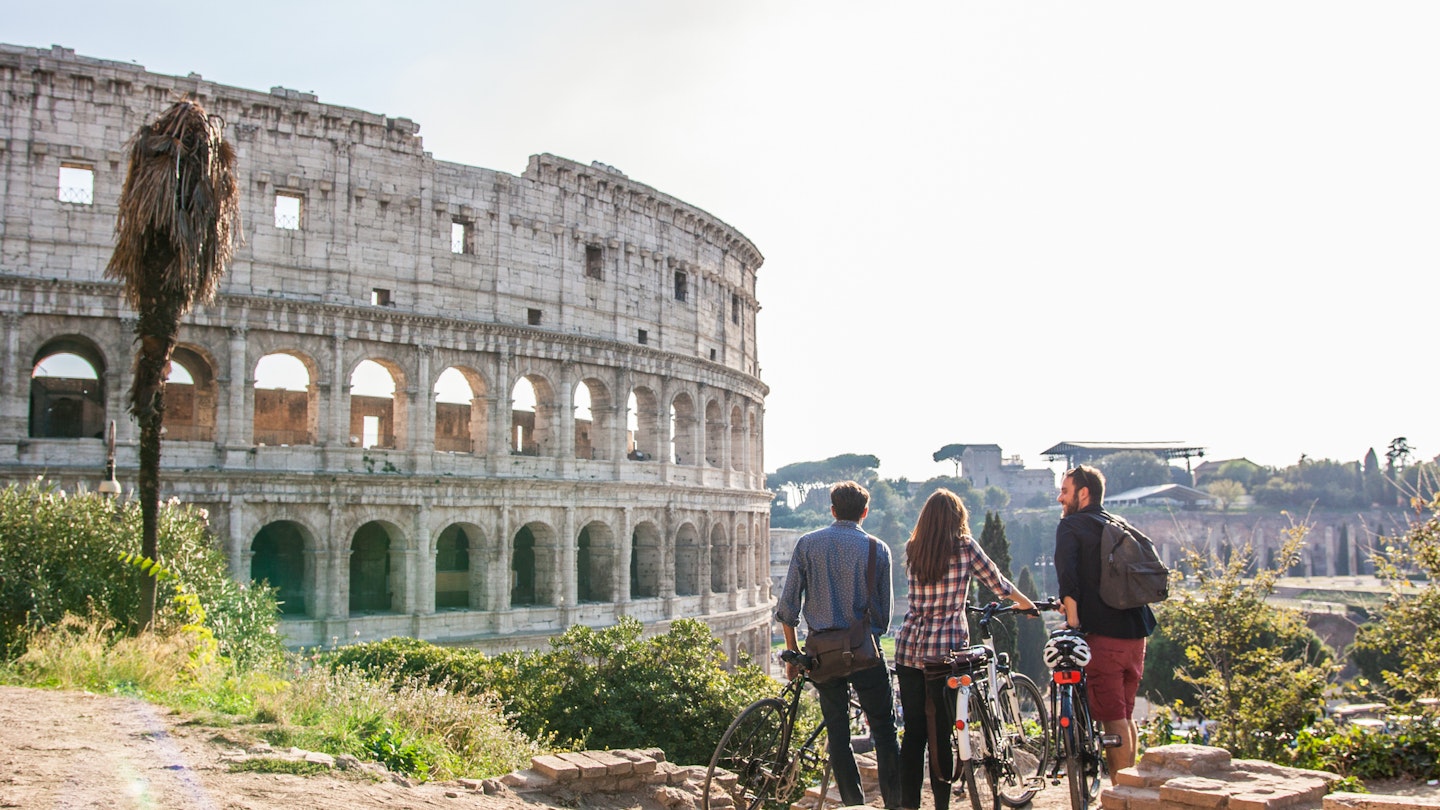
Find your way around in Rome with this guide to transportation and tickets © TFILM / Getty Images
Whether or not you find it easy to get around Rome will depend a lot on what your expectations are.
The most important thing to remember is that Rome is old. Like, old. Most of the streets have not been designed to accommodate people, buses, cars or bikes, and the underground network has been built in and around one of the most archaeologically rich locations on earth. The very things we all come to Rome to see are the very reason that it takes so long to get around it. Keep that in mind the next time you visit and remember that any confusing detours you go on may end up being the best part of your trip!
Here's what you need to know to find your way around in Rome.
Explore the city on mass transit
Just like any major city, the Eternal One has a comprehensive public transport network of buses, trams, and trains that will take you anywhere you want to go. Of course, they may also take you to a few places you weren’t planning on visiting, so it helps to get yourself familiarized before you’re on the ground. Atac, the company that operates all mass transit in Rome, has undergone a facelift in recent years and though some wrinkles are still visible, it’s a pretty convincing nip and tuck. Visitors can download maps in multiple languages from the Atac website , or download the Moovit app to get real-time info.

Metro line C is best for sightseeing
It’s helpful to remember that the two metro lines A and B mostly travel north and south, with the C line heading further to the east. The C will be one of the most familiar sights if you pass through central Rome: archaeological finds at the Imperial Forum station are so proliferate that it’s taken decades to dig for tracks. As a result, the street between the Colosseum and the Forum is lined with heavy machinery and the promise that “it’ll soon be done.” Don’t hold your breath, but don’t sweat it either, and remember that the street is still open to some traffic, so be mindful when crossing the road.
Trams run east to west
Rome’s six small tram lines are primarily useful for traveling east to west and are a good way to see the Trastevere and Monteverde neighborhoods . The trams are a fun, somewhat nostalgic, slightly nicer way to travel as they tend to avoid a lot of the car traffic. Plus, some vintage trams are still in operation, so may get the chance to catch a bit of retro cool as you go.
The tram system plays an important role in the history of modern Rome and it’s worth getting to know a bit of the background (for all of our transit history fans out there). However, an ongoing improvement project on the number 3 tram line means that you’ll need to take a bus replacement service if you want to get across the Tiber, so some of the convenience, and thus the charm of the trams, might escape you.
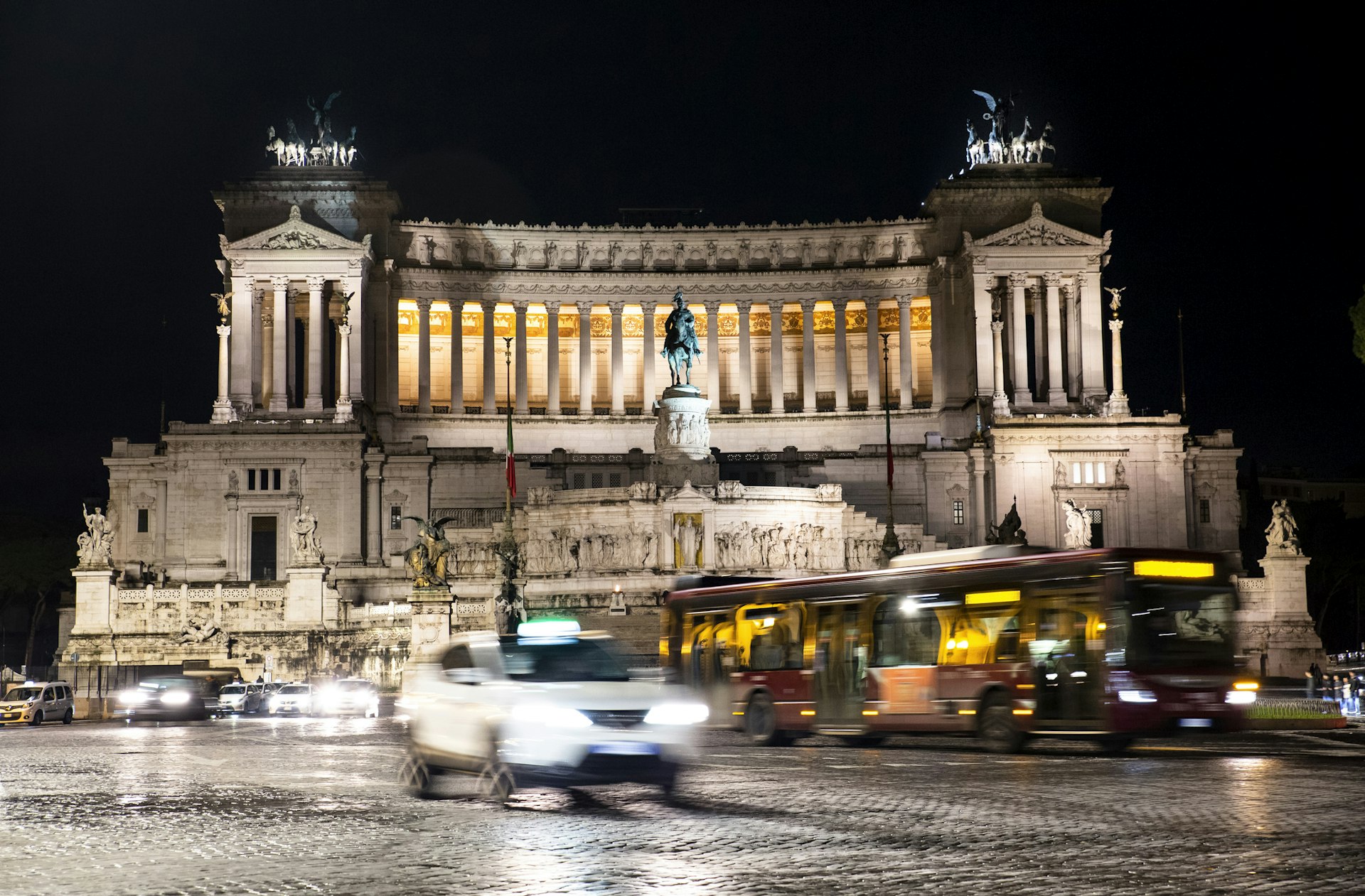
Rome's bus network is extensive
But consider that replacement bus service a good way to dip your toe in the vast bus network, which covers the most ground of any part of Rome’s mass transit system. Riding the bus is one of the best ways to immerse yourself in the cacophony of the city and though the sheer size of the network might feel intimidating, it’s worth doing.
The Atac signage at almost every bus stop can help you go in the right direction, and the Moovit app has up-to-the-minute timetables that will tell you which direction to look. And as always, don’t be afraid to ask people waiting at the same stop: you may get a few grumbles but you’re much more likely to get someone who will not only tell you whether you’re in the right place but will also make sure you actually get on the right bus.
Tickets are valid on buses, trams and metro lines
Travelers can purchase daily or weekly farecards from machines or kiosks located at the entrance to nearly every metro station, and the Tap and Go system is available to anyone with a contactless card as well as smartphones and smartwatches. You’ll be charged for single rides and each is valid for 100 minutes, as with a standard travel card. While the Tap and Go system has become quite reliable in the past year, it still has its share of hiccups and is occasionally out of service for maintenance. It doesn’t hurt to have a ticket in reserve for just such an occasion. Oh and, the ticket machines don’t give more than €6 in change so be aware before you use a €20 note to pay for a €1.50 ticket!

Walking is the best way to see some of Rome's key sites
Walking through Rome is as frenetic and romantic as you think it will be, and you’ll see icons at every turn. Much of the ancient center of Rome, which includes sites like the the Colosseum , the Forum and the Pantheon , is easily within walking distance, and on a nice day, you could cover all of these and much more.
There is always something going on and if you slow down a bit, you’ll find yourself soaking up the ambiance that makes Rome so singular. After all, it’s only by walking that you’d catch the Rose Garden hiding above the Circo Massimo , or the path that winds along the Tiber River. If you want to see Rome for what it truly can be, stop and walk for a while.
Of course, for all its magic, the center of Rome can be extraordinarily congested with foot and car traffic, so navigating these areas sometimes takes a lot of time and even more patience.
Try to avoid peak hours at places that you’re not necessarily going to enter: if you only want to walk around the Colosseum, wait until after it closes at 6pm and the crowds largely dissipate. After all, that’s the magic hour, when the light hits it just right and everything is illuminated with pink and gold hues.
Driving in Rome is best avoided
Here’s the thing. Driving in Italy is an art form, and if you can drive in cities like Rome, you've reached a new level of mastery. Romans drive with an urgency and a logic that will escape everyone else, and while it may seem that they’re aggressive (and they can be) often they’re just moving into openings in traffic that only they can see. Do not attempt to mix in this, as it will inevitably result in confusion on your part and frustration on the part of everyone around you.
Taxis are easy to find
Leave the driving to the professionals, in this case the Romans. Taxis are proliferate, and can be easily ordered via the Free Now app , which will give you fixed rates and allows you to pay through it as well. Uber is also quite reliable around the city and will give you the option of both a taxi or private hire car called an NCC, which stands for Noleggio con Conducente (hire car with driver).
Bikes and scooters are popular, but not always wise
Exercise caution with bikes and scooters in Rome. These have become a popular mode of transportation here just as in other cities around the world. Tours guides are often skilled at helping riders navigate the streets on bikes and scooters, but if you’re not used to riding in busy lanes with uneven sidewalks, you could put yourself (and others) at risk.
Rome is not very accessible
Both the national and municipal governments have been working on improving the city’s infrastructure for people with disabilities, and the ATAC website offers a comprehensive overview of the metro, tram, train and bus services for people with disabilities. According to the ATAC website, 98% of buses are equipped with boarding platforms, 70% of trams have platform level flooring, and the vast majority of metro stations have elevators as well as tactile paths and maps for visually impaired passengers, displays for those with hearing impairments, and Braille messaging. The website also has a handy search function to check whether your station has these services available, and is updated in real time for any service interruptions.
Major sites around the city offer special access to visitors with limited mobility: it’s possible to reserve a wheelchair at the Vatican museums , and the Colosseum has both ramps and elevators to facilitate movement around the monument (that said, the underground parts of the Colosseum are not wheelchair accessible). But there’s no doubt that it’s still slow going on those picturesque cobblestone streets for those with any mobility challenges, including those who might be traveling with small children and strollers. Keep it in mind as you plan your day, and if you’ve got precious cargo in hand try to schedule your iconic visits for off peak hours.
This article was first published April 2021 and updated June 2023
Explore related stories
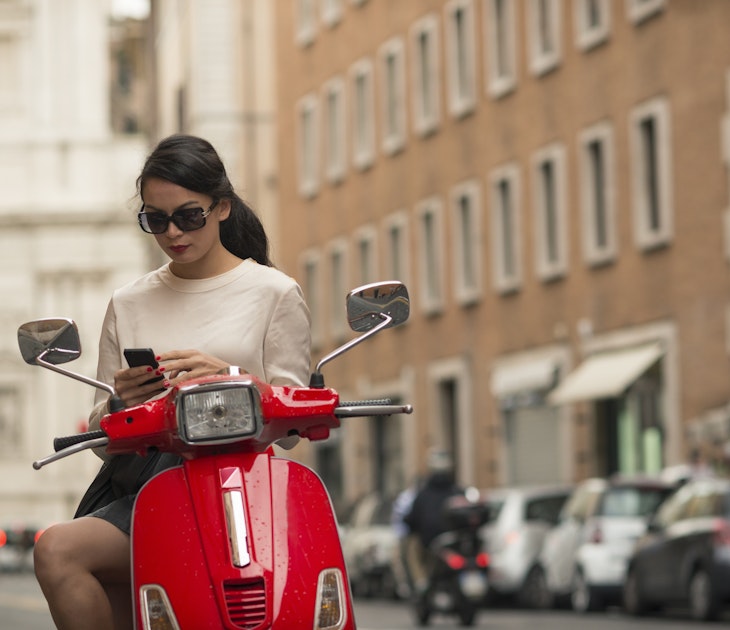
Destination Practicalities
May 30, 2023 • 14 min read
Your guide to traveling independently across Italy, from the Alps to the islands.

Apr 19, 2024 • 7 min read

Apr 8, 2024 • 7 min read
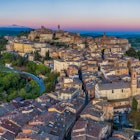
Apr 7, 2024 • 11 min read

Mar 21, 2024 • 6 min read

Mar 15, 2024 • 10 min read

Mar 8, 2024 • 17 min read

Feb 27, 2024 • 9 min read

Feb 27, 2024 • 6 min read

Getting around Rome: Public Transportation
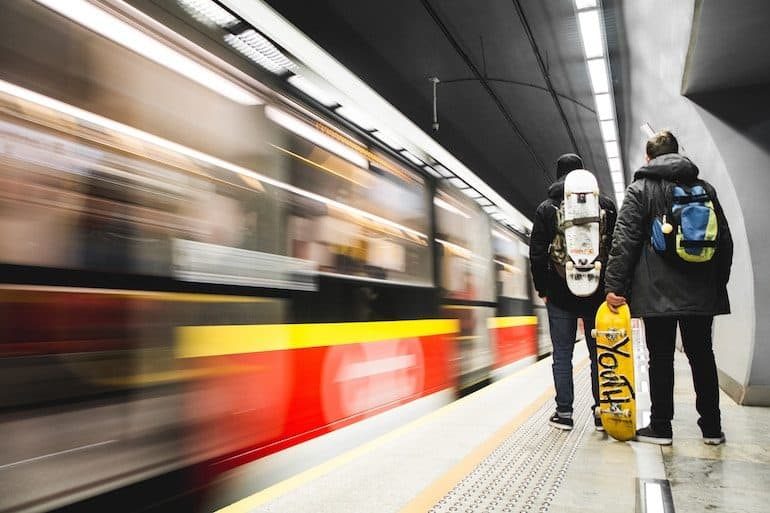
How to use Rome’s public transport
Compared to learning Italian or suffering through bureaucratic procedures, navigating Rome’s public transport system can be one of the easier undertakings for foreigners. As you build a routine commute to university or work, it’s important to find transportation that works best for you and learn how to use it like a native resident. Here’s everything you need to know about Rome’s public transport travel pass options from the metro to the bus and tram.
Where can I buy public transport tickets in Rome?
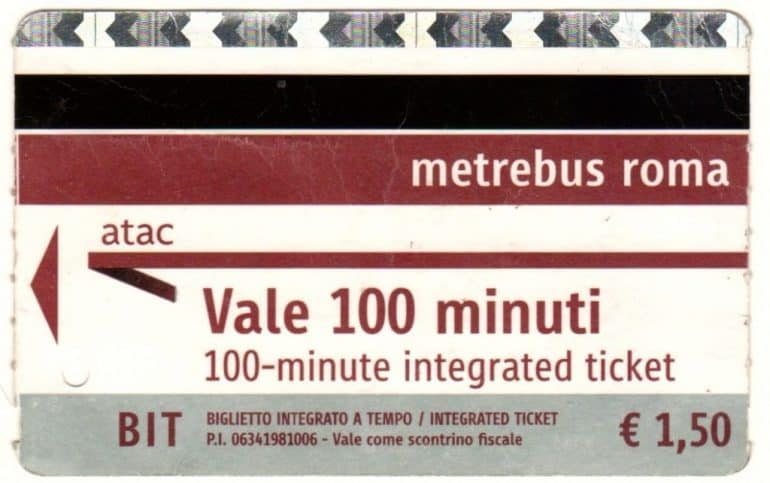
The metro, bus, and tram use the same tickets or biglietti , which you can buy at Tabacchi shops (sops with the black and white T sign), newspaper stands ( edicola / giornalaio ), and metro stations. Or, the app MyCicero is available for iPhones and Androids to easily purchase tickets public transport tickets in Rome (and all through Italy) whenever you want.
How much does public transport cost in Rome?
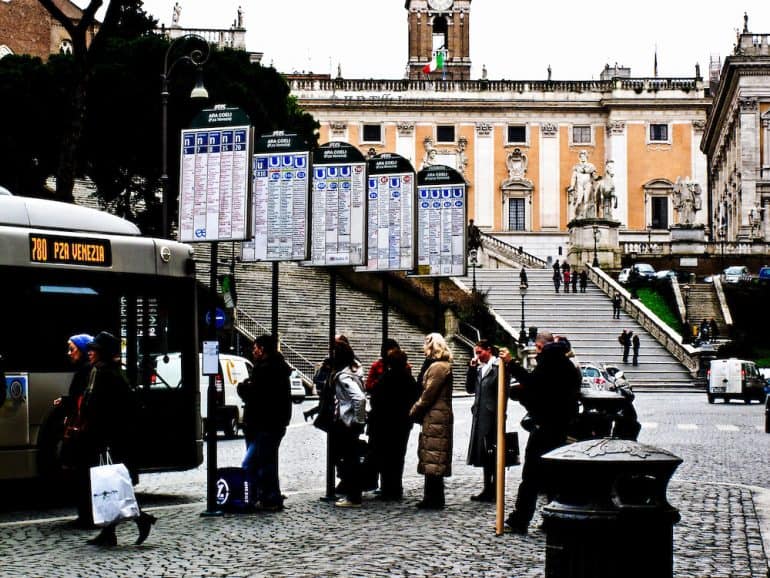
You can buy different public transport tickets depending on how often you use public transportation, ranging from 100-minute use (€1.50) to a one-year pass (€250). A single-use ticket for bus , metro , tram and trains inside the municipality of Rome costs €1.50 and is valid for 100 minutes from activation. The 100-minute ticket can be used for the metro for only one ride, but is valid for unlimited use for trams and buses. Children under 10 years old can ride public transit for free, but for adults there are other tickets for unlimited use for 24 hours (€7), 48 hours (€12.5), 72 hours (€18), and one month (€35 or €53 for a transferable, multi-person use ticket). Discounted tourist tickets for 72 hours (€16.5) and one week (€24) are also available.
How do I validate a public transport ticket in Rome?
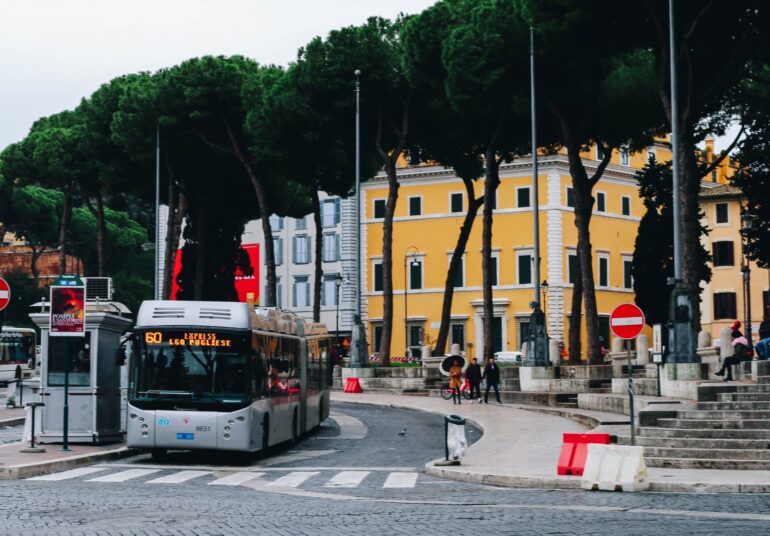
You must validate your public transport ticket when you enter the bus, metro or tram. The metro requires you to scan it to proceed to the platform. On buses and trams, you’ll find yellow boxes to validate your ticket. There is no system on buses and trams that enforces passengers to buy tickets, but there is the risk that ATAC officers (transportation authority of Rome) will check passengers for tickets and deliver a €50 fine to those who haven’t bought or validated their ticket. Some bus lines also allow you to purchase a ticket on the bus by paying an additional €0.50, for a total of €2.
How does the Metro work in Rome?
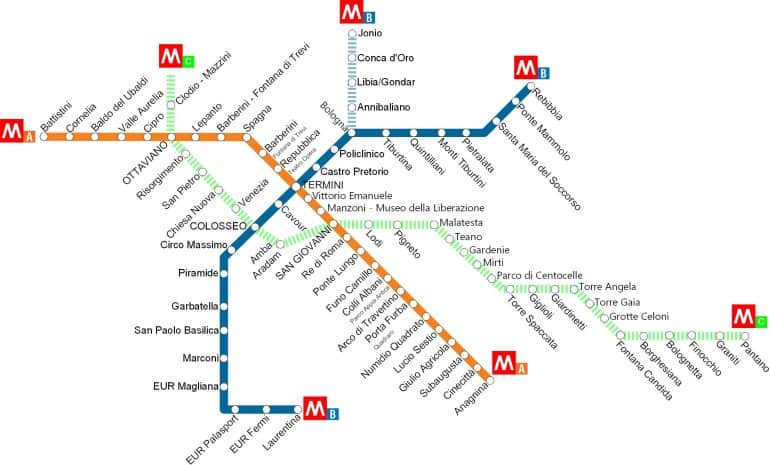
Have you waited forty minutes for the bus and it still hasn’t shown up? Just hop on the metro ! The entrances are easy to spot with their large read “M” signs, and its 74 stations keep you well connected with Rome more reliably than the buses. It currently has three active lines, A and B, and a C line that is not fully active.
Line A (Battistini-Anagnina): You’ll have easy access to popular tourist destinations like Piazza Vittorio Emanuele II, Termini station, the Spanish Steps, Villa Borghese, and the Vatican.
Line B (Laurentina-Rebibbia & Joino): This line will quickly transport you to Porta San Paolo train station, a main station for traveling to Ostia Antica and some beaches, via the Piramide stop. The Colosseum, Circus Maximus, and Termini are also easily accessible.
Line C (Pantono-Lodi) : Rome’s third metro line currently has twenty-two working stops, but is still under construction in the historic center between the Colosseum and Piazza Venezia. Its S. Giovanni station opened in May 2018 and also serves as a museum for the archeological artifacts discovered during its excavation. Intersections to the A and B metro lines are still underway, but changes in the aboveground transportation network around the S. Giovanni stop allow travelers to change from the C to A metro line via bus.
Each metro line has a map inside the stations that shows all the stops. Before heading to the platform, just look at the map for your metro line and make sure your desired stop is between your current location and the last metro stop. The last stops of the metro lines (Battistini, Anganina, Laurentina, Rebibbia, and Jonio) determine which direction and platform to follow.
Metro Hours in Rome:
Mon-Thurs & Sun from 5:30 a.m.–11:30 p.m.; Fri-Sat from 5:30 a.m.–1:30 a.m.
Trams in Rome
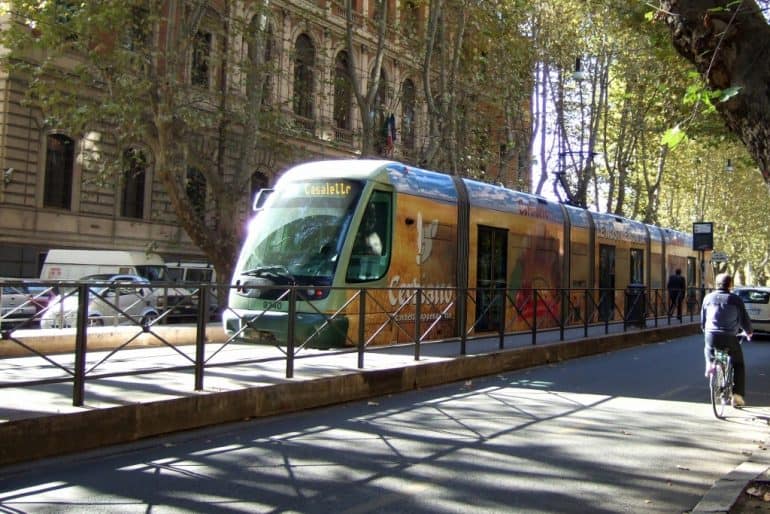
Trams are perfect for relaxing travel within the city and great views of popular ruins. Typically running every six minutes (or every twelve on Sundays), trams also offer a more consistent schedule than buses.
Six lines (the 2, 3, 5, 8, 14, and 19) connect Rome’s tourists and residents around several neighborhoods like Gianicolense, Trastevere, Monti, Flaminio, and Prati. The 8 tram is very convenient to students, running from Trastevere to Piazza Venezia with stops near Campo dei Fiori, Piazza Navona, and Largo Argentina. The 3 tram, stretching from Trastevere station to the National Etruscan Museum, provides a very scenic tour of the city with views of Piramide, Circo Massimo, the Colosseo, and the National Gallery of Modern Art.
Similarly to bus stop signs, tram signs note your location and the trams that run through that stop, or fermata . Each tram line has a list of stops between the first and last fermate on the line, which are clearly bolded. If your desired stop is not between your current location and the last stop, simply switch platforms and take the tram in the other direction. The trams stop at every place on the route, so there is no need to signal your fermata , unlike the city buses.
Tram Hours in Rome:
5.30 a.m. – 12 a.m. daily
Buses in Rome
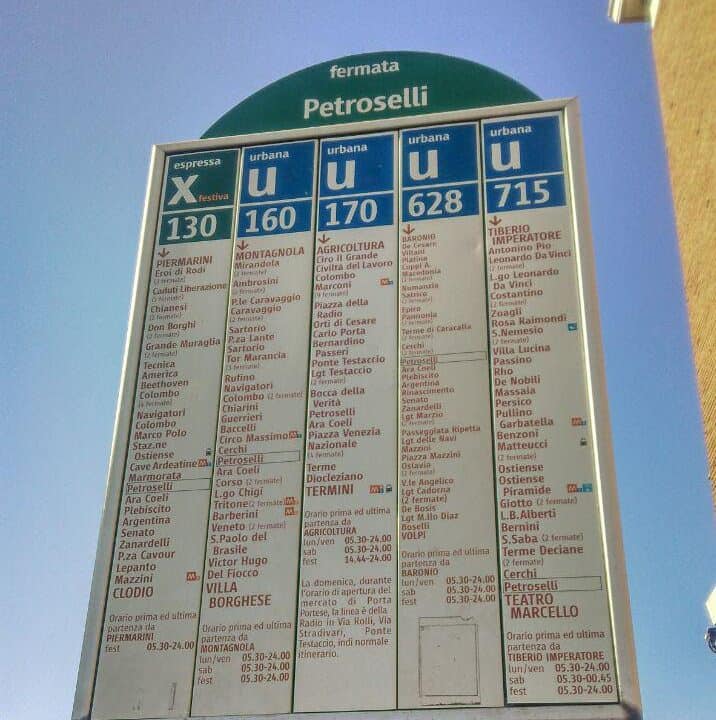
The buses seem to arrive on their own haphazard schedule (or never at all), so don’t forget your headphones and patience for your commute. The lax, erratic arrival times for the city buses imitate the lively rhythm of Roman life, and are a good lesson in accepting the unpredictable happenings in life! Citymapper , Autobus Roma, and Roma Bus (ATAC time bus Rome), are mobile applications and websites that can help smoothen your trip. In Citymapper (which functions in other cities), a list of buses, trams, and trains gives you multiple options for getting from your location to destination. The app also directs you to bus stops with a map, tells you when buses and trains will arrive, and notifies you when you’ve reached your stop if you’re unfamiliar with the area.
Bus stop signs note the location of the fermata , the various buses that run through it, and the list of stops on each bus route. You’ll notice some letters above each bus number–U, N, X, E–that indicate the different bus types. The majority of buses are urban lines (U), but there are also express buses (X) that travel to the outskirts of Rome and exact buses (E) for connecting the center with surrounding neighborhoods on fixed timetables. Night buses (N) replace the urban buses during the late hours. Other information, like changes in bus routes during holidays and festivals, are also noted on stop signs.
The first and last locations on the bus routes determine the direction you need to go in. If your destination is between your location (which is bolded or circled in the long list of stops) and the last stop, you are traveling in the correct direction. If it is above your location, you will need to change bus stops and wait for the bus traveling in the opposite direction. The two stops for each direction are usually across the street from each other or in close proximity.
When you see the bus arriving, approach the sidewalk and motion for the driver to stop. Unlike trams, buses do not stop at every fermata unless someone requests it. When you’re on the bus and ready to get off, press one of the red buttons you see scattered around the windows and doors. Don’t forget to validate your ticket once you’re on the bus. Here’s how to buy a bus ticket in Rome .
Bus Hours in Rome:
Urban lines – 5:30/6am to midnight
Night buses – midnight to 5 or 6 am
Is the Roma Pass worth it?
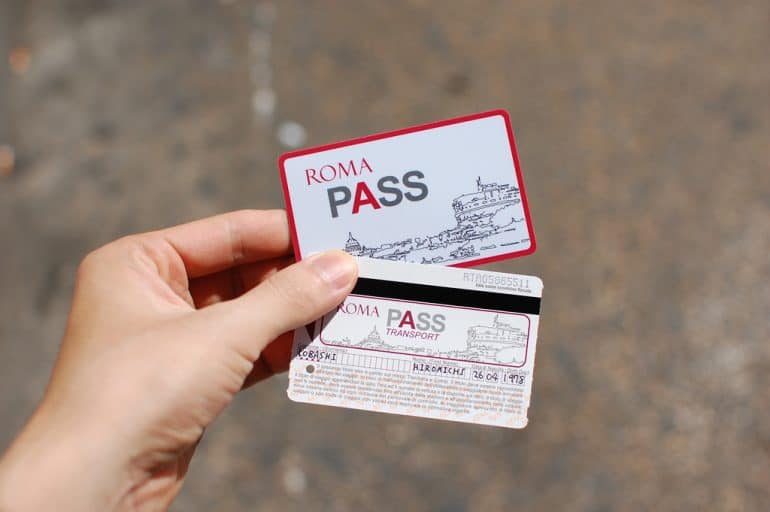
Touring Rome for a few days? If this is your first or second time in Rome and you’re planning on doing lots of sightseeing, the 48 or 72 hour Roma Pass could be worth it. This Pass allows you to visit cultural heritage sites and access public transit with just one card. Tourists can purchase their Roma Passes online before arriving to Italy and begin their exploration of the most exquisite monuments, museums, and archeological sites for discounted prices. Skipping long ticket lines, visiting a network of 50 galleries and museums, and using public transportation with ease makes Roma Pass a must-have resource for exploring Rome.
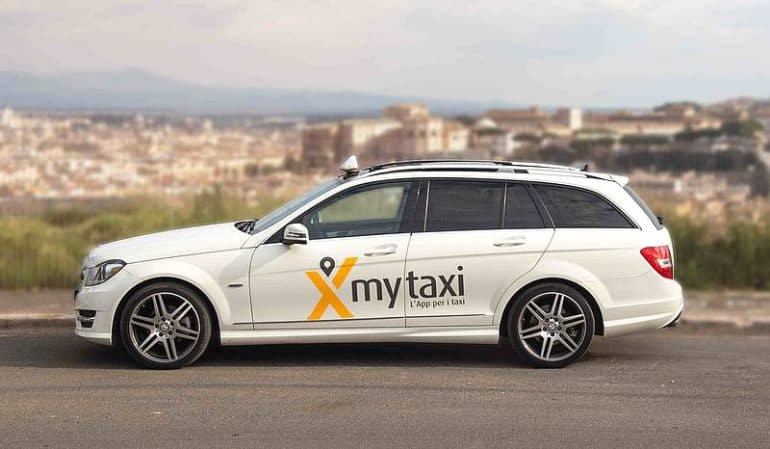
If you’re rushing to the airport early in the morning, calling a taxi may be less stressful for you. To contact a cab in Rome, you can call several different numbers: 06 3570, 06 4994, or 06 5551. If you call when you’re ready for a taxi, you can tell the operator your address, and the taxi will arrive shortly. You can also reserve a taxi for a specific time and pick up spot, and you’ll also have to provide your phone number.
You can also reserve a taxi online, with an app called FreeNow, which works similarly to Uber . MyTaxi allows you to see cabs around your area, estimate the cost of your ride, and track your taxi’s arrival. The app also allows you to reserve a cab ahead of time for early or late departures.
How to get a taxi in Rome

For those feeling adventurous and holding an international driver’s license, renting a car is a great way to see the outskirts of Rome. Noteworthy sights include Lake Bracciano, the Park of Monsters in Bomarzo, and Amalfi coast, but there are many more attractions accessible by car. Drivers must be at least 18 years old and licensed for at least one year. An international license may not be required for some rentals, however it’s highly recommended. Age requirements vary by car category, but drivers under the age of 25 will pay a young driver surcharge.
Rentals are available from major transportation hubs in Rome, such as Termini station, Fiumicino Airport and Ciampino Airport, Tiburtina station, and on Via Cipro (Vatican). One of the coolest is StylishRent – a short-term car rental company that operates all over Italy. Prestigious cars and a top-notch service are at the core of their mission. They strive to provide an unforgettable experience with the maximum of comfort and style. Choose the car you’d like to rent and decide where you want their drivers to deliver your car. Oh, and they also offer a 24/7 service, every day of the week.
If you’re looking to use a car for a grocery run or short 24 hour trip, Car2Go is a hassle-free option. Utilizing the car sharing network is quick and painless with a downloadable app that scans your license (international license necessary for foreigners), provides a map with available Car2Go vehicles, and sends a pin to start the car. Parking is free in public parking areas, and Car2Go will even gift a four euro credit to your account if you refuel the car. You can easily travel within Rome in the “home area,” but dropping the car off in periphery zones will result in a €1.90 fee. Depending on car size, prices range from €.24 – €.29/minute or €.29/kilometer after the first 200 kilometers traveled in long distance trips. Car2Go also offers flat rate rides to and from Fiumicino and Ciampino airports for €9,90 or €5,90.
You might also notice red Fiat 500’s buzzing around Rome. Enjoy is an alternative car sharing experience that uses a similar rental system for quick trips (at €.25/minute) or long hauls. Drivers must be at least 18 years old and licensed for one year, but differently from Car2Go, Enjoy accepts licenses issued from other European countries and the U.S. After registration, you’ll receive a unique pin to unlock any Enjoy vehicle you use, unlike Car2Go that sends you a new pin every time you rent a car. Enjoy also uses a map to find available vehicles that you can book for free, however a fee of €.10/minute kicks in if you don’t begin using the car after fifteen minutes. Enjoy cars are available in Rome, Milan, Florence, Turin, and Catania, and rental trips must end in the coverage zones of those cities. You can travel outside of the coverage zones for an unlimited amount of time (with an additional fee of €.25/km after the first 50 km traveled), but you cannot travel outside of Italy. After your trip, you can park in any public parking area inside the coverage zone for free, or you can use reserved Enjoy parking at Termini, Fiumicino, Ciampino, and other transportation hubs for €9.50 or less.
Check out Rome’s Airports Guide
Check out how to get to and from Fiumicino Airport
Check out how to get to and from Ciampino Airport
Check out the Essential Student Guide: Setting up your life in Rome
Sign up to our newsletter for the latest news, events, and insights from Rome
By subscribing you agree with our privacy policy .
Check your inbox or spam folder to confirm your subscription.
Related Post:

Your email address will not be published. Required fields are marked *
Yes, add me to your mailing list

Buy Visit Rome Pass, your city pass for visiting Rome. +50 attractions and public transportation included in one tourist card.
✅ Free entrance to the main attractions of Rome ✅ Free public transport
Public transport in Rome: everything you need to know to get around the capital
- Places and Tours
Buses , metro , trams and even trains : discover the super guide with all the practical information for getting around Rome by public transport

Moving from one side to the other of a large metropolis like Rome , may seem like a difficult undertaking, and it certainly is, but in this article we will give you all the information you need to get around Rome by public transport , using the metro , buses , trams and railway lines ; and you'll see that once you understand how it works it won't be that difficult.
In this article you will discover everything you need to know to get around Rome. A super guide to public transport with also an overview of the different types of tickets , season tickets and tourist passes that greatly facilitate travel around Rome. Among these, the Visit Rome Pass is highly recommended, a tourist pass which, in addition to access to more than 50 attractions, includes unlimited access to public transport.

Spanish Steps in Rome
Knowing how to use Rome's public transport network is certainly the first step to enjoying your visit to the city to the fullest. First, we must consider that the center of Rome includes a very large surface area . The Colosseum and Roman Forum , for example, are in a very different area than the Vatican Museums or the Spanish Steps . It is therefore essential to plan, at least in principle, your daily itinerary. This allows you to understand more easily which public transports will be essential during the various excursions around Rome .
Subscriptions and passes come to our aid, which will allow you to organize your holiday in a comfortable and practical way. Are you ready to find out which public transport will be useful for your Roman Holidays ? An alternative to public transport, to be considered if you plan trips out of town to pleasant but poorly connected places, is car rental . Vehicle that allows you to take personalized routes , outside the most tested circuits.

Buses and trams: the wide network of public transports in Rome

Altar of the Fatherland in Piazza Venezia
Buses and trams connect all areas of the capital, both in the center and on the outskirts.
There are 6 tram lines , active from 5.30 am to midnight :
- First of all, we mention line 8 , because it is the most interesting from a tourist point of view: it connects Piazza Venezia (Fori Romani area) to Trastevere ;
- Secondly, line 2 connects Piazza Mancini to Piazzale Flaminio ;
- Line 3 connects Piazza Thorwaldsen and Trastevere;
- Line 5 connects Via Giovanni Amendola (Termini Station) to Piazza dei Gerani;
- Follow line 14 which connects Via Giovanni Amendola ( Termini Station ) to Palmiro Togliatti;
- Finally, line 19 connects Piazza Risorgimento to Piazza dei Gerani.
As for buses, the capital offers more than 300 daily lines and more than 20 night lines , counting over 8 thousand stops . Furthermore, a supply of 411 electric buses will arrive in the city by the end of 2024. The lines are active from 5.30 in the morning until midnight , and there are also a series of night bus lines active from midnight to 05.30 in the morning.
If, however, you like to be led, you could choose a panoramic bus tour and get off and on whenever you like at certain strategic points including: the Vatican and Castel Sant'Angelo , San Giovanni in Laterano, the Circus Maximus and many other places of interest.

Metro in Rome, your fastest choice

Complete map of the metro in Rome
There are three metro lines : the first is Line A , characterized by the color Orange , with 27 stations , which connects Battistini to Anagnina , and runs 290 trips a day .
The second is Line B , characterized by the color Blue with 3 terminus: Laurentina, Rebibbia and Jonio and connects 26 stations with 308 trips per day .
The third Line C , marked by the green colour , is the most recent and is still partially under construction. The trains on this line are controlled and guided by a driverless integral automation system, therefore they do not have a driver on board. The line connects San Giovanni and Monte Compatri-Pantano . This line has an interesting history. In fact, during the construction works of the San Giovanni stop , numerous finds from the Roman era emerged which today are exhibited inside the station itself, used as a museum . The terminus of line C will be in Piazza Venezia , right in front of the Altare della Patria.
In general, the metro allows you to reach the main points of interest in the city such as the Spanish Steps , Piazza del Popolo , the Trevi Fountain , the Opera House, the Colosseum and St. Peter's Basilica . The subway is the most convenient and fastest way to move around the capital, used by tourists, but also by the Romans themselves. The metro operates every day from 5.30am to 11.30pm , while on Fridays and Saturdays until 1.30am .
If you travel by public transport it could be very useful to have an audio guide app on your phone, thanks to which you will be able to find constantly updated information on places of tourist importance, attractions, artistic masterpieces and treasures set like precious gems on the hills of Rome.
Trainlines you can consider in Rome

One of the most scenic view's of Rome
On occasions, it may be interesting to consider trains . In fact, there are 12 railway lines in Rome ! There are 8 main ones (whose names begin with the letter F) and 4 special ones.
The Atac company that manages Rome's public transport operates 3 lines that cover the routes from Rome to Viterbo, from Rome to Giardinetti and, finally, from Rome to Lido di Ostia . While the remaining 9 lines are managed by Trenitalia (Italian State Railways).
Among other lines, one of the most useful is the Leonardo Express , which connects Rome Termini station to Fiumicino airport . We then include the FL1 line (Orte – Fiumicino Airport), the FL2 (Rome Tiburtina – Tivoli), the FL3 (Rome Ostiense – Viterbo Porta Fiorentina), the FL4 (Rome Termini – Frascati / Albano Laziale / Velletri), the FL5 (Rome Termini – Civitavecchia), the FL6 (Rome Termini – Cassino), the FL7 (Rome Termini – Minturno - Scauri) and the FL8 (Rome Termini – Nettuno). It is certainly useful to know in which Rome airport to land at in order to secure a means of transport to enter the city. Remember that among the various alternatives available, you could rely on the fast and efficient minivan service for your travel from your hotel or from the center to Rome Fiumicino international airport.
After this overview, it is certainly clear that public transport in Rome is, to say the least, an indispensable tool for exploring all the beauties that the capital offers. We will see how to juggle tickets , season tickets and passes in the next paragraphs.
The ecological choice: moving by bike and on foot

The capital's cycle network extends for approximately 320 km and winds through parks and historic villas and along the main streets of Rome , encouraging the use of active and sustainable mobility not only in free time but also when traveling for work and study. The bike can represent a valid alternative to using public transport or private cars.
It is useful to know that it is allowed to ride public transport with your own folding or traditional bicycle . The folding bike is always free, while the traditional one is free only with Metrebus season tickets.
For some years now, to contribute to improving air quality, the city of Rome has pedestrianized some streets on specific days, on Sundays and on public holidays via dei Fori Imperiali and the stretch of the Appia Antica (from Porta San Sebastiano to the church of Domine Quo Vadis, and from via di San Sebastiano to Via Cecilia Metella) are accessible only to pedestrians and bicycles.
How to use the public transports in Rome: tickets and prices

View of Rome. On the top left, the Altar of the Fatherland
As we have seen, the company that manages the capital's means of transport is Atac .
There are numerous solutions offered by Atac for the use of tickets which are valid not only for buses and trams , but also the underground and regional railways (in the latter case, the tickets are valid only in second class and on the Rome routes – Lido of Ostia, Termini - Centocelle, Rome - Viterbo).
Here are the proposed solutions :
- The single ticket , valid for 100 minutes from stamping (on the subway it is valid for a single journey and allows you to change lines A-B and A-C), at the price of 1.50 euros .
- The booklet includes 10 single tickets at a cost of 15 euros .
- There is an integrated weekly card , valid for 7 days starting from the moment of the first stamping which allows unlimited travel on public transport at a cost of 24 euros .
- Tickets: Rome 24h (7 euros); Rome 48h (12.50 euros) and Rome72h (18 euros).
Tickets can be purchased at tobacconists , newsstands , at the vending machines available at the main bus stops and at the metro stations, but also at the ATAC ticket offices and inside the train stations. Metro tickets can also be purchased via contactless credit card.
It may also be useful to know that children up to 10 years of age, if accompanied by a paying adult, have free access to the main public transport in the municipality of Rome.
It is always advisable to consult the ATAC official website to stay updated on any news or changes. Alternatively, some mobile applications are also available that provide solutions on routes, on connections between the different stops, on timetables and any delays: the main ones are Viaggia con Atac and Roma Mobilità , the official applications of the public transport company.
Tourist Pass to explore the capital of Italy: the most convenient solutions

Trevi Fountain, Rome
In addition to single tickets, there are passes that allow unlimited travel on Rome's public transport lines for 48 and 72 hours. They are tourist-cultural cards , the counting will start from the moment of the first stamping and in addition to full access to public transport, the 48h card allows free entry to the first museum, archaeological site or experience; while the 72h card includes 2 free entries.
Finally, once again we suggest the Visit Rome Pass option, the advantage of this pass is that it includes access to more than 50 attractions combined with unlimited use of public transport , it is present in version 2, 3 or 7 days .
We recommend


How to Buy Pantheon Tickets in Rome

How to skip the line at St Peter’s Basilica

How to skip the line at the Borghese Gallery

How to skip the line at the Colosseum – 2024

How to skip the lines at the Pantheon

How to skip the lines at the Vatican – 2024

Should I get a Roma Pass?

The best time of day to visit the Colosseum

The best time of day to visit the Vatican Museums | Opening hours 2024

The cheapest way to skip the lines at the Vatican | 2024

What are the official websites to buy tickets for Rome’s major attractions?

Vatican and Sistine Chapel tickets

How to get past Colosseum ticket buying problems – 2024

How do I travel to Rome from Fiumicino airport? 2024

How do I get into Rome from Ciampino Airport? 2024

How do I book train tickets around Italy?

Hop-on-hop off bus tours

August 15th is Ferragosto, a national holiday, and many things in Rome are shut

How do I buy a slice of pizza in Rome?

How do I buy cigarettes in Rome?

How do I mail a letter in Rome?

How do you use the bidet when on vacation in Rome?

How much cash to bring with you to Italy

How to buy vape supplies, e-cigarettes and juice in Rome

How to cross the street in Rome (and live to tell the tale!)

How to get English-speaking medical treatment in Rome

How to order a coffee in Rome

How to visit Rome with children

How to visit Rome’s Olympic Stadium

How to visit the mosque in Rome

The difference between St. Peter’s Basilica, the Sistine Chapel, and the Vatican

The difference between the Colosseum, Roman Forum, and Palatine Hill

What is the dress code in Rome?

What kind of electrical adapter do I need to bring to Italy?
What should I see if I have only one day in Rome?

Where are the best views of Rome?

Where can I buy a used bike in Rome?

Where can I find a wifi cafe in Rome to work in? 2024

Where can I run in Rome?

Where’s the bathroom in Rome?

12 reasons you shouldn’t drive a car in Rome

Avoid common problems with Rome’s public transport

Can I travel to Rome at the moment?

Can I use Uber or Lyft in Rome? 2024

Getting to and from Rome Ciampino airport at night

How do I get to and from Fiumicino Airport (FCO) at night?

How to buy a ticket for Rome’s public transport system using an app

How to get from Rome’s Civitavecchia port into the city

- How to not get pickpocketed

How to use Rome’s public transportation network – with map – 2024

Rome’s “secret” train that gets you across the city in 20 minutes – for only 1 euro

Scooter sharing: renting an electric scooter in Rome
The best way to get from the airports into Rome (and back again)

Aperitivo: Rome’s low-cost drink and food extravaganza

Become a Spritz Specialist and a Pasta Pundit

Beer in Rome

Do I need to tip in Rome?

Food tour in the heart of Rome

Hooch and History: the Tipsy Tour of Rome

How to avoid being ripped off at a tourist trap restaurant in Italy

How to cook perfect pasta

How to eat gluten free in Rome

How to eat vegan and vegetarian in Rome

How to use an Italian stovetop coffee pot

Pasta and Tiramisu class

The truth about sandwiches in Rome

What to order in a restaurant in Rome

What’s the difference between a Ristorante, an Osteria, and a Trattoria?

Why you never need to buy water in Rome
- Where to stay in Rome

Colosseum Arena tour with Forum and Palatine Hill

How to visit the Coppedè Quarter in Rome

Off the beaten track to see the beaten track: Via Flaminia Antica

Orientation tour: self-guided piazza walk

Rome Vacation Tips Eternal City Night Walk

Rome Vacation Tips guided walk of the Baroque City

Rome Vacation Tips tour of the Colosseum, Forum, and Palatine Hill

Rome Vacation Tips VIP Vatican Tour

Self-guided walking tour around the ancient city

Terrifying ghost tour of haunted Rome

The Popes, Domes, and Tombs Tour of St Peter’s

Where can I see Caravaggios for free in Rome?

Basilica di San Clemente: the most interesting historical site in Rome

Guided Modern Architecture Tour Of Rome

Guided Street Art Tour in Rome

Rome’s other “Jewish ghetto”

San Lorenzo in Miranda – a church in a temple

The optical illusion of St Peter’s Basilica from Via Niccolò Piccolomini

Villa Torlonia: ersatz architecture and Mussolini’s home in Rome

Where can I see street art in Rome?

Can I splash in the fountains in Rome?

How to avoid the African bracelet scam

How to get a Covid test in Rome with English language certificate – 2024 update

Special rules for visiting the Vatican during the coronavirus pandemic

What to do in Rome in an emergency

What’s with all the trash in Rome?

Why do shopkeepers in Rome never seem to have any change?
- Book train tickets around Italy
- Day trip to Tuscany
- Day trip to Pompeii
- Things to do in Florence
- Things to do in Milan
- Things to do in Naples
- Things to do in Tivoli
- Things to do in Venice
- How to Vacation in Dublin
- How to vacation in Istanbul
How to get around Rome by public transport
One very cheap fare or transport card allows you to use almost all means of public transport in Rome with the exception of taxis and airport transport. Buses, subway trains, trams (streetcars), and light rail are operated by the same company called ATAC. You can hop on any of their transport using the same ticket. Here’s how.
Where can I buy single tickets for the Rome public transport system?
Tickets are available from machines at all Metro stations. These machines allow you to select an English Language interface (shown by the British flag not the stars and stripes). They take euro bills and coins, but not credit cards even though many of them have a credit card slot. But beware: they never dispense more than €6 in change ( resto )! The machine will happily eat your €20 bill but won’t give any of it back until you’ve bought €14 worth of tickets.
However recently many of the machines won’t accept bills of more than €10. Finally the depressingly common fuori servizio or guasto signs both mean ‘out of order’. All is not lost though: you can also buy these tickets in most tabacchi – tobacco stores, distinguished by the “T” sign outside. Go to the cash register and ask for un biglietto (oon beel-YET-oh) or “ X biglieti ” ([number] beel-YET-ee”) to get the standard 100-minute ticket (below).
Things are changing though: new, orange ticket machines are being rolled out slowly throughout the Metro network that take credit cards and dispense all types of tickets.
Can I use contactless payment in Rome’s public transport system?
Yes, but right now only on the Metro. All turnstiles are fitted with a contactless payment tab that will accept contactless credit and debit cards, as well as NFC-enabled phone payment systems (i.e. G-Pay and Apple Pay).
Tapping your payment method will automatically debit your account by €1.50, granting you 100 minutes’ use of the transport system including one Metro ride.
ATAC claims it will roll out the same “tap-and-go” system throughout the entire system, including trams and buses, but until then you will need a ticket to board these means of transport (unless you’ve already tapped into the system in a Metro station).

Is there an app that I can use to buy tickets?
The “ MyCicero ” app allows you to buy tickets for the Rome transport system.
How to buy a ticket using MyCicero…
Can I get a city card that includes the Rome public transport network?
The most famous city card is the Roma Pass . This gives unlimited access to the city’s public transportation system for 2-3 days, two free entries to major sights, and discounts to museums, though not to the Vatican. However this option does not include airport transfers, the card has to be physically picked up from an office, and some visits still have to be booked in advance. Read more…
What lines can I use my transport ticket or card on?
Lines shown below can all be accessed with the ATAC tickets mentioned below. This includes all the way to the beachside town of Ostia Lido – you can honestly get there for €1.50 each way! Note for the gray lines on the map – commuter rail lines – stations in red indicate the furthest extent of ticket validity: i.e. you can’t use the standard ticket to travel beyond the station in red; after that you would need a train ticket purchased in the originating station. You can also use your ticket on the “FL” main train lines that cross the city , but again only within city limits.
Does Rome’s public transport go to the airports?
Unfortunately the network does not extend to the main Fiumicino Airport. To get to FCO you must take a train or private transport. Read more here…
Ciampino Airport is in fact served by the public transport network, but it is a slow and tricky journey involving bus and Metro. Read more here…
How reliable is public transport in Rome?
It’s not always reliable, but public transport in Rome is cheap and there’s a lot of it. The bad news is it can be slow and subject to delays and strikes .


How do I use the metro in Rome?
Rome’s Metro is simple. It’s just a big X that meets in Termini. There are two fully viable lines: Linea A (red) and Linea B (blue). Linea B splits at Bologna and either goes to Rebbibia or Jonio. Both lines are rather superannuated. The third line, Linea C (green) is partially constructed.
Modern, efficient, clean driverless Linea C runs from Montecompatri way outside the city to join the rest of the network at San Giovanni where you currently have to leave one part of the station and enter another part (be reassured that your single-use metro ticket will allow you to do this) but will eventually cross the entire city.
Locals’ tip: the new part of San Giovanni station has a fantastic display of some of the thousands of artefacts that were dug out of the ground during its construction .
How early/late does Rome’s Metro run?
The first train from each end of the metro lines (see map) is 5.30am every day. The last train leaves from the ends of the metro at 11.30pm on weeknights, and 1.30am on a Friday and Saturday night. That means if you’re in the center and it’s just after 11.30/1.30 you may still be able to catch your metro.
What kind of ticket should I buy to use the Rome public transport system?
There are numerous kinds of ticket available:
- 100 minutes . Probably the best value for money for individual trips, this gives you just over 1 and a half hours to use ANY means of transport mentioned above (although it only allows one ride on the Metro), for the teensy price of €1.50. Note that these are the standard tickets available from the tabaccaio .
- Day ticket . Not recommended. It costs €7 and expires at midnight of the day you buy it. It’s only good value if you take at least five journeys more than 100 minutes apart, which is probably unlikely.
- 48 hour . €12.50. Also poor value: see ‘day ticket’ above.
- 72 hour . Again, a false economy. If you need transport for three days and are sightseeing too then it’s probably worth considering a Roma Pass instead.
- Weekly ticket . Bad value: the price of €24 means you need to make 16 journeys in seven days in order to break even. It expires at midnight on the seventh day, so unless you buy one early in the morning you are automatically cheated out of half a day.
In all of the above ‘daily’ cases, unless you’re going far and wide with many journeys, it’s probably far more cost-effective to fill your wallet with a small stack of 100-minute tickets since they don’t expire and can be rolled over to the next day.
- Monthly ticket. The tessera mensile is amazingly good value at only €35 for unlimited travel. If you’re staying for a while it’s definitely worth considering. However these cards only run from the first day of the calendar month to the last, so if you arrive mid-month you can still buy one, but should probably consider other options. Available from ticket offices in major stations.
- Roma Pass . If you’re touring Rome for three days or so, this is fairly good value. It provides public transport for two or three days ( not 72 hours: it expires at midnight on the third day after you buy it), as well as free entrance to two museums, but not including the Vatican. Read more.. .
How do I validate my ticket?
When you board the Metro or commuter train, you pass through a turnstile that will automatically validate your ticket for you (it prints the expiry time and date on the back of the ticket using the word “scadenza”). However if you take a bus or a tram you have to do the validation yourself – if it is the first time you have used your ticket during its allotted time period. If you’ve already validated it once and it’s still valid, you don’t need to do this, and nor do you need to validate a travel pass such as the Roma Pass .
Note that travelling without a validated ticket can get you up to a €150 fine. Once you have figured out which bus or tram to take – try this website – board the bus and you will note a little blobby machine attached to a pillar at the front and back of the vehicle. Insert your ticket and it will be stamped with the expiry on the back, and you’re good to go. (If the bus is particularly crowded, and you wave your ticket and indicate the machine, the friendly Roman crowd will usually pass it to the machine for validation then pass it back to you!)How do I use the metro in Rome?
Now make sure you don’t miss out: plan your visit in advance:
| Plan your vacation
| emergency.
Read this now >
| Book your hotel
| popular articles.
- How to use Rome’s public transportation network – with map – 2024
- How to skip the lines at the Vatican – 2024
- How to skip the line at the Colosseum – 2024
| Recent articles

Related posts

Photo credit: AFP
Tickets in advance!
Because of ticket supply problems following the end of Covid restrictions, it is strongly advised that you buy tickets and tours in advance to visit attractions in Rome.
Buy your tickets now to avoid disappointment.
Rome sightseeing and popular attractions
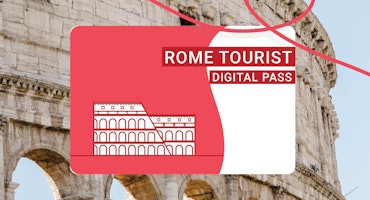
Rome Tourist Card
Snap up the Rome Tourist Card and you'll get everything you need to explore Rome's top highlights including Colosseum, Palatine Hill, Roman Forum and Hop on/off bus. You can even choose the order you see things in.
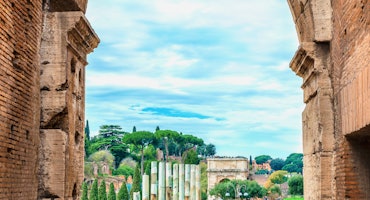
Colosseum, Roman Forum & Palatine Hill: Priority Entrance
Skip the long lines at the Colosseum with this priority-entrance ticket. This ticket will let you bypass the crowds. And after exploring the Colosseum you can head to the area of the Roman Forum and the Palatine Hill.

Vatican Museums & Sistine Chapel: Skip The Line
This ticket will make you save stress and time by allowing you to get priority entrance and skip the line. Visit the the countless masterpieces by Michelangelo, Raphael, Caravaggio, Tiziano and the Sistine chapel.

Borghese Gallery: Fast Track
Galleria Borghese is located in the villa of the park Villa Borghese. Admire the architecture and furnishings of this beautiful villa. It is a museum full of art from the Renaissance. The collection includes several sculptures and paintings. Because of limited capacity get tickets for this museum weeks in advance.

St. Peter’s Basilica: Dome Climb with Guide
Get the most out of your visit to St. Peters with a guided tour to climb the basilica’s dome designed by Michelangelo and admire one of the stunning view. After the tour, you can explore the the basilica at your own pace.
Public Transport in Rome
No matter how much you want to, you cannot simply walk throughout Rome without having any means of transportation. While it is true that the city of Rome is a one big museum in itself, you still need some vehicle to travel, unless you wanna carry your one week worth of luggage from the airport to your hotel room. Just kidding. Still, the distances between some landmarks to others are not exactly proper walking distance. The good news is that Rome provides you with tons of choices on how to enjoy your trip.
Rome, like any other big city, has metros, busses, trams and taxis for public transportation. Different people prefer different modes of transport. Each one has its advantages and disadvantages as well.
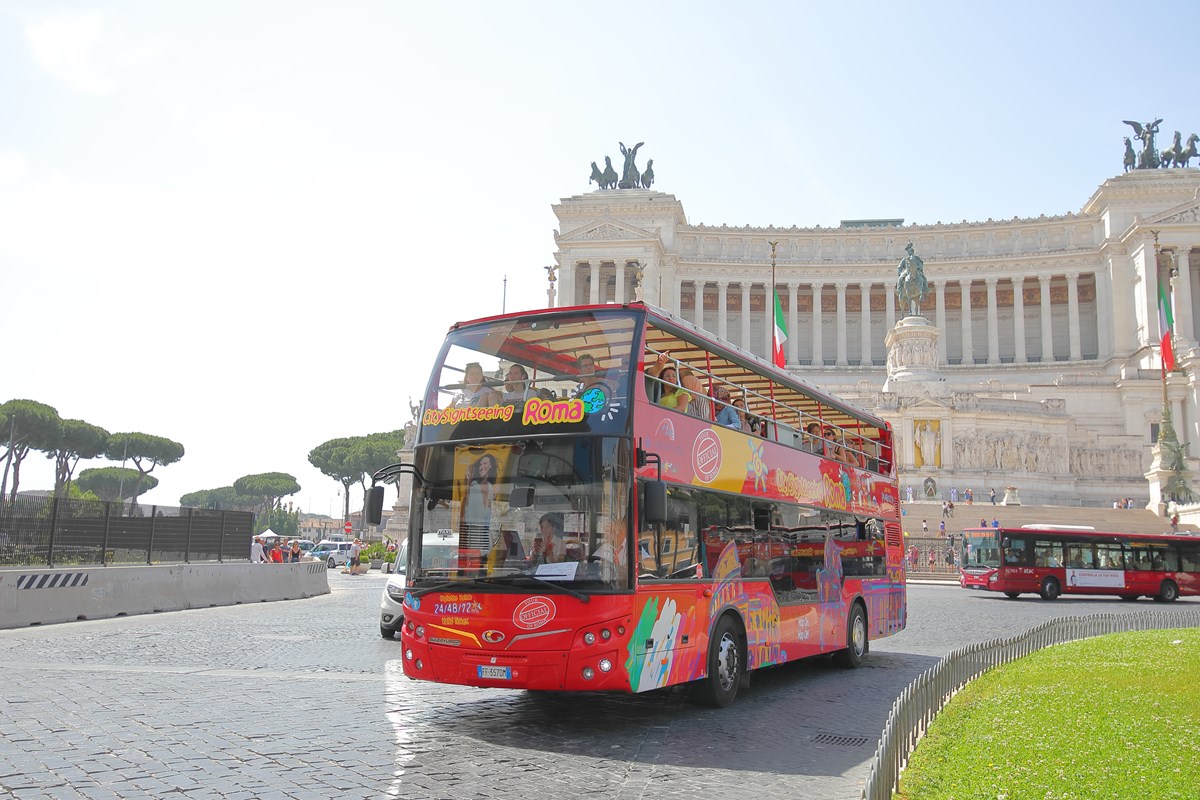
For instance, the subway or metro has a train that leaves the station every five minutes. What’s good about it is that you don’t have to wait too long and plus, you get to your destination faster. However, metros can get very busy: in fact they often do. It also stops at stations which may not be exactly what you want.
As for bus rides, it has more stops than the metros have. It drops you off at major tourist destinations making it an easy way to travel from one landmark to another.
Taxis are the most comfortable means to travel Rome, however it’s more expensive than the metro or bus. Good thing is that you get the car to yourself, so you can make it stop anywhere and anytime you like. Just in case you pass by souvenir shop and want to check it out, you can simply ask the taxi driver to do so because you won’t be disturbing any other passengers anyway.
Majority of the public transports in Rome is run by ATAC (Azienda per la mobilita.) The rest is managed by COTRAL (Compagnia Trasporti Laziali.)
For more information about how you can get through the streets of Rome and other things about public transport in Rome, visit their websites.
TIP: You can buy public transportation tickets in either a tobacco shops or a ticket kiosk. You can even choose from the four different cards.
- BIT – ticket valid for one metro ride or 75 minutes of bus ride, costs €1 ($1.30)
- BIG – ticket valid all day on all (*) types of transport in Rome, costs €4 ($5.25)
- BTI – ticket valid for three days on all (*) types of transport in Rome, costs €11 ($14.35)
- CIS – card valid for a whole week on all (*) types of transport in Rome, costs €16 ($21)
* – Except the Fiuimicino airport and the Tivoli
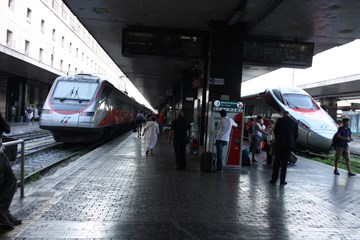
Rome has two main metro lines that go around, rather than through, the historic city. However, there is one special line that runs from the Fiumicino Airport going to the Termini Central Station where you can ride in any of the two train lines… Read more…
There are several bus routes in Rome. Most depart and arrive at the Termini Central Station. Daytime buses run from 6:00 AM to 12 Midnight. Between, 12:30 AM to 5:30 AM, night buses are available too… Read more…
Running from 5:30 Am to 12:00 Midnight, trams in Rome are the largest in Italy. However, many of the routes today are replaced by buses. There are six tram lines running in Rome to date… Read more…
For those who do not like to travel in crowds, you can opt to travel comfortably via taxi. It is not advisable to hold taxis in the streets for too long. The streets are so busy that most will just keep on going. There are lots of taxi ranks in Rome… Read more…
You might also like
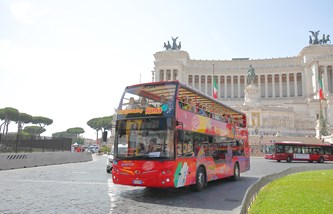
Buses in Rome
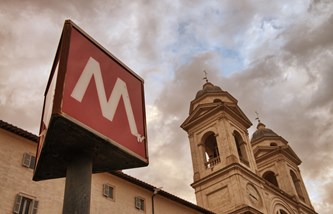
Best Selling Rome Travel Guides
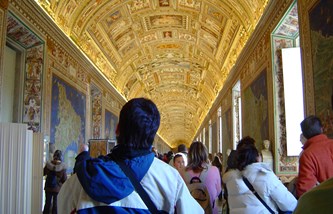
The Vatican Museums & Tickets
RELATED LINKS
On this page, rome public transport, tourist transport & passes, rome fiumicino airport, rome ciampino airport, civitavecchia cruise port.

- Rome hotels
- Venice hotels
- Florence hotels
- Naples hotels
- Pisa hotels
- Sorrento hotels
- Rome Fiumicino Airport
- Rome Ciampino Airport
- Venice Marco Polo Airport
- Pisa Airport
- Naples Airport
- Civitavechia (Rome) Cruise Port
- Naples Cruise Port
- Rome public transport
- Venice water bus (vaporetto)
- Florence public transport
- Naples public transport
- Sorrento local buses beyond Amalfi
Rome public transport tickets and travel passes
Make informed ticket purchase for travel on rome metro, buses, trams and train services.
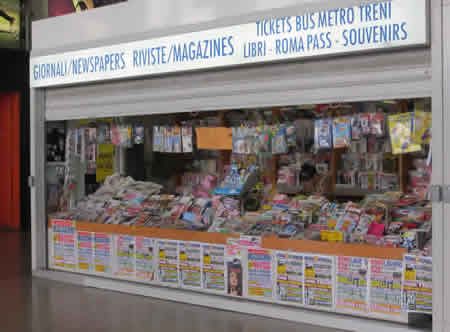
The great thing about travelling by public transport in Rome is that all tickets are integrated. One ticket will get you around on buses, trams, trains and the Metro very cheaply.
Tickets are also easy to purchase as they can be picked up from any of the numerous kiosks in most tourist areas, particularly in places such as Termini Station . From January 2023 contactless payments will also be accepted across the ATAC network.
You can now also purchase a 72-hr public transport ticket in advance of your trip and have it sent to your home address, this allows you to be completely prepared upon arrival. Buy your 72-hr Public Transport Pass in advance now.
There are a few different types of tickets to choose from, including 100 minutes to weekly passes, which we go into details on further down the page. The general rule of thumb though is that if you're going to be using these transport options for less than 5 journeys in one day, the 100 minute ticket is suitable for the majority of tourist needs.
Rome is a stunning city to walk around with treasures found round every corner so don't discount walking around certain areas as the best option.
ROME BUS, TRAM & METRO PRICES 2024
Public transportation is free for children under 10 years old, with accompanying adult.
Top of the page
About rome public transport, what you can use public transport tickets on.
Public transport tickets are valid for all city public transport - city buses and trams , Metro and some rail services within the Rome urban area.
Ticketing on Rome public transport is comparatively simple, there are no complicated travel zones or peak/off peak travel periods.
What's not covered by Rome public transport tickets
There are a few transport options you cannot use public transport tickets on.
For the visitor the main choices not covered are:
- The Leonardo Express train running non-stop between Fiumicino Airport and Rome's Termini Station.
- Any airport bus or train to either of Rome's two airports, Fiumicino or Ciampino.
- The trains to and from Rome's cruise port, Civitavecchia .
- Rome's hop-on hop-off sightseeing buses.
Your transport ticket choice
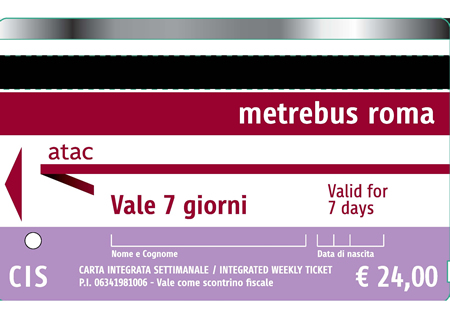
For short term visitors to Rome you have a very straight forward choice of ticketing options.
Your only decision is whether you need single tickets or 24, 48 or 72-hour passes or a 7 calendar day travel pass.
A single ticket is valid for 100 minutes, allowing you to switch bus lines if there is no direct service. On the metro you can switch Metro lines at Termini Station with one ticket.
When you buy any transport ticket it is not stamped with a start date.
You have the responsibility to stamp your ticket on machines provided for that purpose before you start your journey.
If you travel with a blank unstamped ticket it's no different to travelling without a ticket at all.
The tickets themselves are card with a magnetic strip like the 7-day travel pass image here.
Contactless payments work in the same way they do everywhere else, you tap on the reader as you go. You can pay with card, device or download an app. A ticket inspector will ask to see your card/app if they need to check you have paid for travel.
Rome bus, tram & Metro fares & tickets
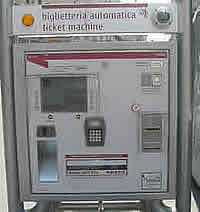
All local public transport is integrated in Rome. You have to purchase your tickets before you board any public transport in Rome. Most people will have a pass of one kind or another.
Tickets for both the bus system and Metro can be purchased from tobacconists, bars, or vending machines at Metro stations and major bus stops. On both buses and metro there is a flat fare, whether you go one stop or to the end of the line. On buses your ticket is valid for 100 minutes allowing you to change buses using a single ticket.
From January 2023 contactless payments will also be accepted across the ATAC network.
At Metro stations there are ticket barriers where you have to insert your ticket to enter and leave the Metro station.
On buses and trams you will find ticket validation machines similar to that pictured below. If you have a single ticket then enter the ticket into the machine. If you have purchased a pass, you put the pass into the machine on your first journey. This stamps the date and time from which the pass or ticket is valid.
Groups of ticket inspectors from time to time descend on to a bus or platform to check all passengers have valid tickets. If not you will incur a heavy fine. Playing the innocent tourist doesn't work.
Where to buy your public transport tickets
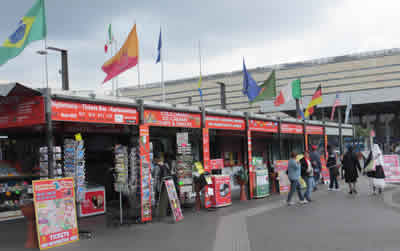
You can buy the travel passes from a variety of sources including vending machines and manned ticket offices at Metro stations and many news-stands / tobacconists like the one pictured at the top of the page.
If you don't speak Italian and are nervous about using vending machines, rest assured most of the people serving at the outlets where tourists frequent normally speak good English, often much better than your hotel.
Most independent visitors to Rome will arrive in Rome city centre at Termini Station. Many kiosks within the station like the one pictured at the top advertise they sell transport tickets.
Out the front of Termini Railway Station by the bus station is the row of kiosks pictured here that specialise in selling travel passes and tours. They advertise the transport passes prominently with prices displayed boldly and staff speak good English too.
These kiosks are conveniently situated next to a Rome public transport information kiosk.
Ticket machines are multi-lingual, easy to use and seemingly reliable. There are manned ticket counters at the key stations. You can also decide to just pay as you go using a contactless card/enabled device.
As yet there is no facility provided by the public transport authority themselves for advance purchase over the internet though there are a couple of options offered by third parties aimed at the first time tourist visitor.
Recent developments have allowed us to now offer a 72-hr Rome Public Transport Pass that you can purchase before you arrive in Rome. This pass is posted to you at home before you leave for Rome, so you can use public transport straight away upon arrival.
Buy your 72-hr Public Transport Pass in advance now.
Validating your public transport tickets
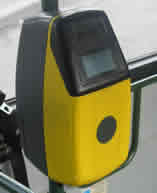
When you first purchase a travel pass or ticket it is blank.
The travel pass only becomes 'live' after you have validated it (stamped with the date you first use it). Showing a ticket inspector an invalidated ticket is no different to having no ticket at all.
On the Metro lines the travel pass is automatically validated when you pass through the ticket barriers for the first time.
On other modes of transport there is a validating machine inside buses and trams and on the platforms of train stations where it is your responsibility to insert your pass into the machine and get it validated.
Single ticket are valid for 100 minutes from the time stamped on the ticket. On buses and trams you can switch routes within this timespan and on the Metro you can switch Metro trains at Termini Station without going through any ticket barrier.
24hr, 48 and 72hr passes are valid from time of validation to the end of the period stated on the card.
Finding your way around
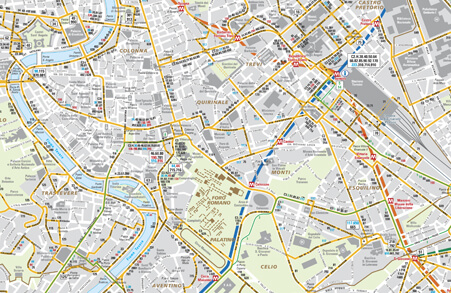
Most visitors will only be travelling in a compact area in the centre of Rome where all the main attractions and hotel districts are situated. The Metro system is very simple, at the moment just 3 lines, only two of which are of use to tourists.
If the Metro is not the solution to an individual journey then the local city buses will be the answer. At first sight the number and complexity of bus routes can seem overwhelming.
On the ground less so, as each route at each bus stop is laid out clearly with all the stops to its terminus. There is normally at least one direct bus going to the destination you require on short trips. Buses are very frequent too.
The bus and Metro map, (link above) covers all of the central area if you want an orientation of routes in advance.
If you are planning on using public transport extensively to get around Rome and visit attractions outside the tourist hotspots in the centre then investing in a Rome bus and Metro map is worthwhile. You can find these sold in most news-stands around bus and train stations like Termini Station.
Outside the front of Termini Station, the main local public transport hub in Rome there is a public transport information kiosk for tourists on one side of the bus station.
Roma Cristiana tour bus plus Rome public transport bundle (1 & 3-day tickets)
Save time and money with the Vatican and Rome card!
It's a straight forward proposition, combine the Roma Cristiana hop on, hop off city sightseeing bus with a 1 or 3 day public transport pass .
The public transport covering all of Rome's metro, tram, suburban train and bus system. Roma Cristiana is one of Rome's leading Hop On, Hop Off sightseeing buses that visits all the major sights in the city of Rome.
Both are combined in one convenient and money saving pass that covers all your transport requirements when visiting Rome.
Travelcard Vatican & Rome
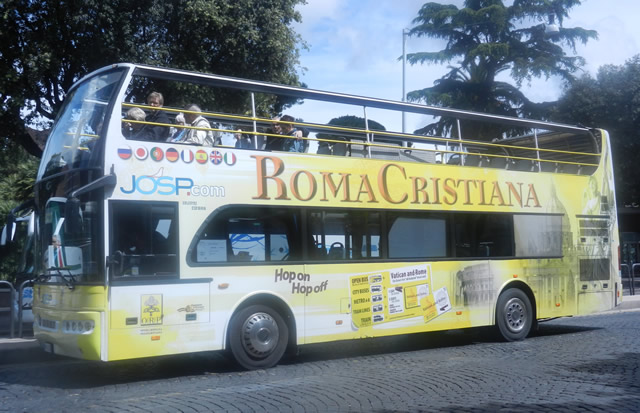
• Includes hop-on, hop-off bus, metro, public bus, tram and trains • Children under 10 free • 1-day or 3-day tickets available
Omnia Card - 3-day pass hop-on hop-off bus, public transport pass, Roma Pass & Vatican Card
Adult €129, child (6 to 17 years old) €59.
The Omnia Card is the most comprehensive sightseeing pass.
When you buy this exclusive travel and sightseeing card, you get access to all Rome’s public transport with a 3-day public transport pass, the Roma Cristiana hop-on, hop-off sightseeing bus, Roma Pass and Omnia Vatican Card.
The pass is offered through Opera Romana Pellegrinaggi (ORP) a branch of the Vicariate of Rome, organ of the Holy See directed by the Cardinal Vicar of the Pope.
This complete solution to your transport and sightseeing needs include:
Roma Cristiana hop-on hop-off sightseeing bus
3-day public transport pass
Fast track admission to Vatican Museums and Sistine Chapel with the Omnia Vatican Card
Fast track admission to St. Peter’s Basilica with the Omnia Vatican Card
The Roma Pass with free entry to two top Rome attractions like the Coliseum, Borghese Gallery, Roman Forum and Palatine Hill and Capitoline Museums
Discounted entry to more than 30 other Rome attractions with the Roma Pass
Omnia Card Rome
• FREE entry to two top attractions including the Colosseum • Includes hop-on, hop-off bus • 3-day public transport pass • Fast-track to Vatican and Sistine Chapel • Fast-track St Peter's

Share it straight to social media with your campaign ID and name
Rome Tourist Bus, City Sightseeing
- 7.70 / 10 1,879 reviews | 32,196 travellers very good all services contracted by CIVITATIS, TRANSFERS, TOURS - rating 10 10 Carlos Augusto
- Free cancellation up to 24 hours before the service starts
Traveling on the City Sightseeing Rome tourist buses is the best option to get to know the main points of interest of the Italian capital. You can choose between different routes with numerous stops where you can get on and off as many times as you want!
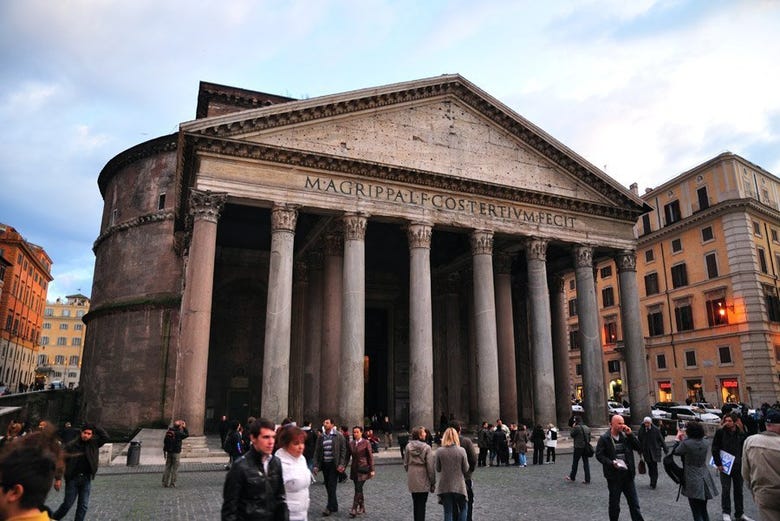
Hop-On-Hop-Off Sightseeing Bus
The Rome sightseeing buses make different stops at the most interesting points of the city. To learn more about the route, you can consult the following map:
- Rome Tourist Bus Stops
This ticket will give you access to the City Sightseeing Rome buses, as well as to the Vatican&Rome Open Bus, the 2 main companies operating in the city.
How does it work?
If you choose the 24, 48, or 72-hour ticket, the validity will depend on the time you validate the ticket . For example, if you start using the 48-hour ticket on a Monday at 1 pm, it would be valid until Wednesday at 1 pm.
During this time you can get on and off the different buses as many times as you like . For example, when you arrive at the Colosseum, you can get off to visit it and then take another bus to continue the journey to the Vatican.
Schedules & Frequency
Buses run daily from 9 am to 5:45 pm every 15 to 20 minutes . Please note that these schedules are flexible and subject to change.
When booking a multi-day ticket, we advise you to check the timetable to ensure that the buses operate on all the days you intend to use them.
Itinerary Changes
The service may be affected by traffic jams, occasional events, and weather phenomena.
More Information
1 day - 3 days.
The activity takes place with recorded commentary in English.
24, 48, or 72–hour unlimited use of the Rome tourist buses
Individual headsets with commentary in English
When to book?
You can book up to the start time, as long as there are places remaining. Book now to guarantee your spot.
Type of voucher
Electronic. Show the voucher on your phone.
Accessibility
Wheelchair accessible. An accompanying person is required.
Sustainability
All services published on Civitatis are carried out in accordance with our Sustainability Code .
Our providers commit to:
- Provide a safe and satisfying experience.
- Reduce, reuse, recycle.
- Incorporate eco-conscious technologies.
- Uphold fair employment standards.
- Foster the growth of local communities.
- Preserve the integrity of local culture.
- Safeguard both cultural and environmental heritage.
- Ensure ethical treatment of animals.
- Operate with honesty and transparency.
- Encourage sustainable behaviors among customers and staff.
This particular activity contributes as follows:
- No single-use plastics are used.
- No printing of documentation required.
Sightseeing Experience Srl Show more
Corporate name: Sightseeing Experience Srl
Frequently asked questions
Q - Are the tourist buses wheelchair accessible?
A - Yes, but it will depend on the number of available spots on each bus. If the bus is full, you'll have to wait for the next one.
Q - Why do this activity with Civitatis?
A - At Civitatis we guarantee the best quality and prices, click here if you want to know how we select our activities.
Q - How to book?
A - To reserve the activity, choose the date and complete the form on this page. You will receive your confirmation immediately.
If you have any other questions please contact us.
Free cancellation
You may also be interested in.

Vatican Museums & Sistine Chapel Guided Tour
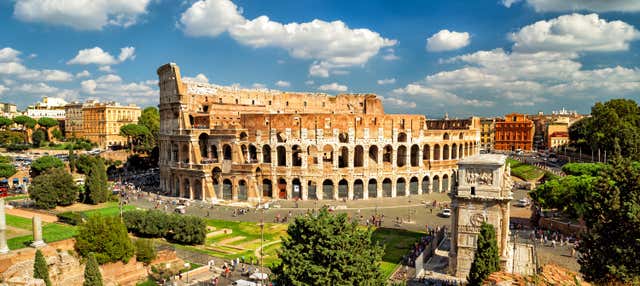
Colosseum Tour + Gladiator's Entrance

Sistine Chapel, Vatican Museums + St Peter's Basilica
Trains in Rome
Trains may not be your most used mode of transportation while in Rome, but it’s still worthwhile becoming familiar with the system.
Whether you want to travel further afield in Italy or simply arrive in the centre from the airport, it’s useful to know more about the city’s train network.
Rome Train Stations
Unsurprisingly, regular train stations in Rome are not quite as widespread as the metro stations. There’s only a handful in central Rome and even fewer that are relevant to tourists.
- Termini Station is the main train station in Rome – more on that later – and the one most visitors will become familiar with, but there are a few others that you may come across.
- Trastevere Station . Rome’s leafy, bohemian neighbourhood of Trastevere has its own station, which primarily operates regional and suburban train services. It’s handy for reaching this popular district, which isn’t accessible via the metro, and is on the FL1 line from Fiumicino Airport.
- Ostiense Station. Close by is Ostiense, just a short distance over the river from Trastevere. Another station, Sao. Paolo is only around the corner. Both operate regional lines and are close to Testaccio and the Baths of Caracalla.
- Tiburtina Station. Tiburtina is one of the larger train stations in Rome but isn’t likely to be on most visitors’ radar. It’s located a bit further out from the centre than most people venture – though high-speed trains and national lines run from here, you’re more likely to be travelling from Termini.
- Porta San Pietro. This is a smaller station than the others listed here, but San Pietro does have some useful transport links. It’s most notable for its location close to the Vatican but is also known for its link to the port city of Civitavecchia.
- Ostia Antica. This small station isn’t technically within the city limits of Rome but is only 30 minutes by train from Ostiense. Ostia is an ancient port city and was a significant hub of trade and commerce in Ancient Roman society. Well worth the short journey.
Termini Station
Termini Station is the biggest train station in Rome and the main transportation hub in the city. If all roads lead to Rome, then all train lines lead to Termini Station (well, close enough.).
It’s a sprawling station, and you’d be forgiven for thinking it’s a shopping mall at first glance. There are three floors, though the third is primarily for dining; you can go shopping, lounge outside a cafe, or eat a full meal – there’s plenty to do while you wait for a train.
Reaching Termini from the Airport
While it has connections within the capital, generally for visitors, Termini Station is where you’ll go to travel to other parts of Italy or the airport.
It’s 35km from Fiumicino Airport and about 30 minutes by train. You can arrive at Termini from Fiumicino via the Leonardo Express Train; it’s the fastest way to reach the station from the airport but is twice as expensive as other options. Unless you’re in a hurry, personally, I don’t think it’s worth it.
Though the FL1 regional train won’t take you directly to Termini, it does reach central Rome. You can get off at Trastevere, for example, and wander into the centre from there (or catch a taxi).
Arrive early
If departing from Termini Station, it’s worth arriving around 15-20 minutes before your train is due to depart. This is one of the largest train stations in Europe – if your train platform happens to be on the other side of the station, you’ll need the extra minutes to reach it.
It will also make everything feel less stressful; you need that extra time to get your bearings, check the departure boards, and find your platform. If you need to get your ticket upon arrival, add another five minutes.
Types of Trains
Besides the metro, there are a few different types of trains in Rome. It might look like an intimidating list, but in reality, the differences are minimal; it mostly boils down to speed and the area covered.
- National. For longer-distance travel, like going from Rome to Naples.
- High-Speed Trains. Rome is a major hub for high-speed train services in Italy. Trains such as Frecciarossa, Frecciargento, and Italo operate from Rome’s main train stations.
- Urban and Suburban Trains. Rome has several urban train lines that connect the city with its suburbs and nearby towns. These trains are mostly used by commuters traveling between residential areas and city centers or passengers traveling shorter distances within the city. There are plenty of stops on these trains, so they’re not the quickest.
- Regional Trains. Regional trains are really a blend of local, suburban trains and lines that go a little further afield – they’re not just for commuters. The majority of these trains are operated by Trenitalia.
- Intercity Trains. Intercity trains cover medium to long distances, connecting major cities and towns. They offer a slightly slower but more affordable alternative to high-speed trains.
Train Tickets and Fares
Like the other public transportation tickets, the fares for trains in Rome are very reasonable. They’re also easy to purchase – you can buy tickets at the station, from a machine, or, at larger stations, the counter. But it’s arguably easiest to buy tickets online beforehand.
Most trains are operated by Trenitalia ; you can download the app and show your ticket on your phone. Visit the Italo website for high-speed train tickets. If you’re planning a longer journey, it may be easier to book through Rail Europe or ItaliaRail .
As for ticket options; it will depend on the length of your journey. For longer-distance trains, like a trip from Rome to Milan or Naples, you should buy tickets in advance; both for price and availability.
There are discounts available for people aged under 26, seniors and students, and deals for families travelling together. Check the train company’s website for exact details and prices, as they’re subject to change.
A single or return ticket bought on the day will be common for short to mid-length travel. And while most beyond the city won’t, for journeys that do fall within the right parameters, the classic B.I.T, or 100-minute ticket, will work. At only €1.50, it’s a really cost-effective way to travel over short distances.
A few examples of destinations included in this coverage are Lido di Ostia, Viterbo and Giardinetti.
Train Passes
As mentioned, a limited number of train lines are included in the Atac, city of Rome public transport network.
Most train lines are not included in the main tourist passes , barring a few shorter journeys into the suburbs; if they fall within the transport network of the city of Rome they should be included. It’s always worth double-checking before you embark on any journey, however.
For the eligible lines, a Roma Pass will allow you unlimited travel. This tourist card grants access to a few different tourist sites, and gives you unlimited access to Rome’s public transport network (buses, trams, metro, and some trains). The three-day pass is €52, while the 42-hour Roma Pass is available at €32.
Visitors looking to explore beyond Rome and travel the country by train may be interested in the Eurail Italy Pass. This pass is only valid on the Trenitalia network, but offers unlimited rail travel in Italy for 3, 4, 5, or 8 days, which can be used over the course of a month.
A Trenitalia Pass is aimed at foreign visitors travelling around Italy; prices start from €129. The exact pass can be selected to suit your needs; choose from Easy, Comfort, and Executive options, pick the number of journeys, ranging from 3, 4, 7, or 10, and the type of passenger; Adult, Senior, or Youth. You can travel on Frecce, FrecciaLink, Intercity, Intercity Night, and EuroCity Italy-Switzerland trains (only on domestic routes within Italy).
Accessibility
Rome doesn’t have the best track record when it comes to accessibility – though it is improving.
Practically all mid to long-distance trains are accessible, including Intercity lines. It gets a little less predictable for local and regional lines. The majority of trains have designated wheelchair spaces – but you do have to notify the train company 24 hours in advance to reserve one. Last-minute travel isn’t really an option.
The train lines have phone lines for passengers with accessibility needs to call with any queries. Getting in touch in advance to guarantee accessibility and allow them to make any necessary arrangements is your best bet.
There are wheelchair lifts in many stations and accessible toilets on many trains. Braille can be found on all signage in accessible trains, and stations take extra steps to make sure they are suitable for the hearing or visually impaired. While the train network in Rome and Italy isn’t perfect, it is a lot better than it used to be.
What is the train system in Rome called?
Not to be confused with the subway system in Rome, which is simply the metro, the train system doesn’t have a name as such. Train lines will have names, like FL1, or be referred to as ‘local’ or ‘regional’ – most are operated by Trenitalia, so some may refer to them by the company name.
What is the best train station in Rome?
‘Best’ is subjective, but the largest station is Termini, and it has the most amenities in quite some way.
How do you pay for a train in Rome?
You can purchase tickets at the station, either at a ticket machine or from the counter. You can also buy your ticket on the app, which is easy and generally cheaper if purchased in advance.
What are the different train stations in Rome?
To see all the train stations in Rome, take a look at a map on one of the train companies’ websites. The most relevant train stations to tourists in Rome are Termini, the largest by far, and Trastevere, Ostiense, and San. Pietro.

IMAGES
VIDEO
COMMENTS
Essential Information About Rome's Public Transportation. Hours: Buses, trams, and commuter trains operate daily from 5:30 a.m. to midnight, with limited night bus service available. The Metro is open from 5:30 a.m. to 11:30 p.m., Monday through Friday and Sunday (until 1:30 AM on Saturdays). Key Routes: Some key bus routes for tourist: 40 (St ...
Rome's public transportation system consists of buses, trams, metro, and train lines conveniently connecting every corner of Rome. Although Rome is a very walkable city, sometimes you need to rest your feet up or travel a little further afield. Public transport is a great, cost-effective way to get around the Eternal City - here's what ...
Whether or not you find it easy to get around Rome will depend a lot on what your expectations are.. The most important thing to remember is that Rome is old. Like, old. Most of the streets have not been designed to accommodate people, buses, cars or bikes, and the underground network has been built in and around one of the most archaeologically rich locations on earth.
If you're visiting Rome for the first time, explore how to get around Rome by metro, bus, tram, taxi, suburban trains and trolebuses. Civitatis Rome. Travel Guide General Information Info . close. General Information. ... Rome Tourist Bus, City Sightseeing. 7.68 1874 reviews . US$ 35.40. book. Vatican Museums & Sistine Chapel Guided Tour. 8.86 ...
To call a taxi within Rome, you can try 06 3570, 06 4994, 06 6645, 06 5551, or 06 8822. ... If you're using public transport, the metro and buses are the best way to travel around Rome. What is the cheapest way to get around Rome? Walking, of course. But in all seriousness, public transport, in general, is very cheap in Rome. ...
Rome Tourist Passes Roma Pass With the Roma Pass you can make unlimited use of the ATAC public transport for 48 or 72 hours. You also have access to one or two attractions (including the Colosseum, Castel Sant'Angelo and Galleria Borghese).After booking you can easily pick up this ticket at the airport.The prices of the Roma Pass are:
This is a cost-effective ticket if you're planning on taking several trams, buses, and metro rides during the day. For €7, you'll get unlimited use of public transport in Rome from the first time it is stamped and for the next 24 hours. 48-Hour Ticket. The 48-hour pass works just like the 24-hour one. It costs €12.50. 72-Hour Ticket:
Rome public transport tickets are available from bars, tourist booths, convenience stores, tobacconists (called tabacchi ), newspaper kiosks that display the ATAC emblem, and vending machines in all metro stations and at major bus stops. You should have a ticket before boarding any form of public transportation.
There are only three lines, so it's easy to navigate. The metro operates between 5:30 a.m. and 11:30 p.m. Sunday through Thursday and runs until 1:30 a.m. on Friday and Saturday nights. Line A ...
Taxis. If you're rushing to the airport early in the morning, calling a taxi may be less stressful for you. To contact a cab in Rome, you can call several different numbers: 06 3570, 06 4994, or 06 5551. If you call when you're ready for a taxi, you can tell the operator your address, and the taxi will arrive shortly.
A super guide to public transport with also an overview of the different types of tickets, season tickets and tourist passes that greatly facilitate travel around Rome. Among these, the Visit Rome Pass is highly recommended, a tourist pass which, in addition to access to more than 50 attractions, includes unlimited access to public transport.
The Leonardo Express Airport Train is the fastest and most convenient mode of public transport between the airport and the city center. The first train leaves around 5:30 from Rome Termini. The service runs till around 22:30. The first departure from the airport is at around 6:30 and the last one is at around 23:30.
Rome tourist transport services and passes. Hop-on hop-off sightseeing bus. There is an overwhelming choice of different lines offering a classic double deck open top sightseeing bus, operating a hop-on, hop-off service to all the main sights and attractions in Rome. Private car tours.
Also poor value: see 'day ticket' above. 72 hour. Again, a false economy. If you need transport for three days and are sightseeing too then it's probably worth considering a Roma Pass instead. Weekly ticket. Bad value: the price of €24 means you need to make 16 journeys in seven days in order to break even.
TIP: You can buy public transportation tickets in either a tobacco shops or a ticket kiosk. You can even choose from the four different cards. BIT - ticket valid for one metro ride or 75 minutes of bus ride, costs €1 ($1.30) BIG - ticket valid all day on all (*) types of transport in Rome, costs €4 ($5.25) BTI - ticket valid for three ...
The BIT ticket is great value for money. You can use it on buses, trams, the metro, and some urban trains. As the main tourist sites are very walkable, many visitors will find that they use the transport system only once or twice a day at most; for these people, the BIT ticket is easily the best value. It is, however, slightly more inconvenient ...
In Rome, visitors can purchase different types of transport tickets and travel cards depending on the number of days they stay in the city and how often they plan on using public transportation there. ... The 48-hour ticket allows unlimited use of Rome's public transport for 48 hours from the time it is first used.
Ticket Type Price; B.I.T standard ticket - valid for one metro ride or 100 minutes on all buses allowing transfers: €1.50 24-hour ticket - valid for unlimited metro, bus, and train travel within Rome for 24 hours from validation: €7.00 48-hour ticket valid for unlimited metro, bus, and train travel within Rome for 48 hours from validation
Since the metro lines of Rome are rather limited, visitors will most likely need the bus public transport system to get to certain parts of the city. It may not be the most comfortable or punctual form of transportation.. Nevertheless, to get to certain monuments and museums it is essential to use the bus.. Currently, Rome has 338 bus lines that run throughout the day, 22 night buses and 8,260 ...
4.2 (535) From $27.84. Line A is orange on the subway map; Line B is blue; Line C is green. Line A and Line B run in opposite directions, meeting in the middle at the central railway station. Rome's transport network of metros, buses, trams, and trains. Line A & B cross in the center of the subway map.
The Rome sightseeing buses make different stops at the most interesting points of the city. To learn more about the route, you can consult the following map: Rome Tourist Bus Stops; This ticket will give you access to the City Sightseeing Rome buses, as well as to the Vatican&Rome Open Bus, the 2 main companies operating in the city. How does ...
How Rome2Rio works. Rome2Rio searches any city, town, landmark, attraction or address across the globe with thousands of multi-modal routes to easily get you from A to B. 198,965. Train Lines via. 6,002 Train Operators. 969,666. Bus Routes via. 79,538 Bus Operators. 13,273.
For the eligible lines, a Roma Pass will allow you unlimited travel. This tourist card grants access to a few different tourist sites, and gives you unlimited access to Rome's public transport network (buses, trams, metro, and some trains). The three-day pass is €52, while the 42-hour Roma Pass is available at €32.